#Manila garbage emergency
Explore tagged Tumblr posts
Text
Manila Faces Health Emergency as Garbage Crisis Escalates
Newly-elected Manila garbage crisis Mayor Francisco Domagoso has issued a grave warning about a mounting garbage crisis in the Philippine capital, urging nearly two million residents to keep their rubbish indoors as the city faces a potential public health emergency. Domagoso, also known by his screen name Isko Moreno, took office on Monday and immediately confronted the city’s worsening trash…
#Francisco Domagoso#health risks from rubbish#Isko Moreno#Manila garbage emergency#Manila waste management#unpaid contractors Philippines
0 notes
Text
Two Plans, One Goal: Family and Disaster Preparedness
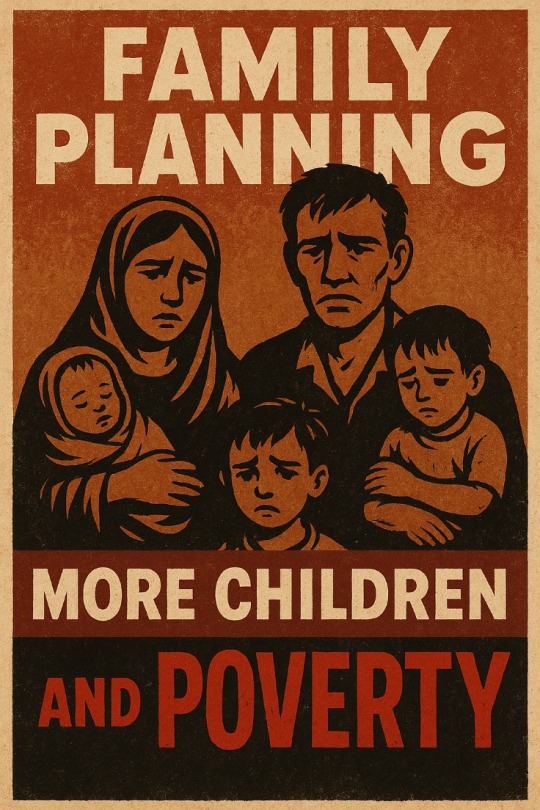
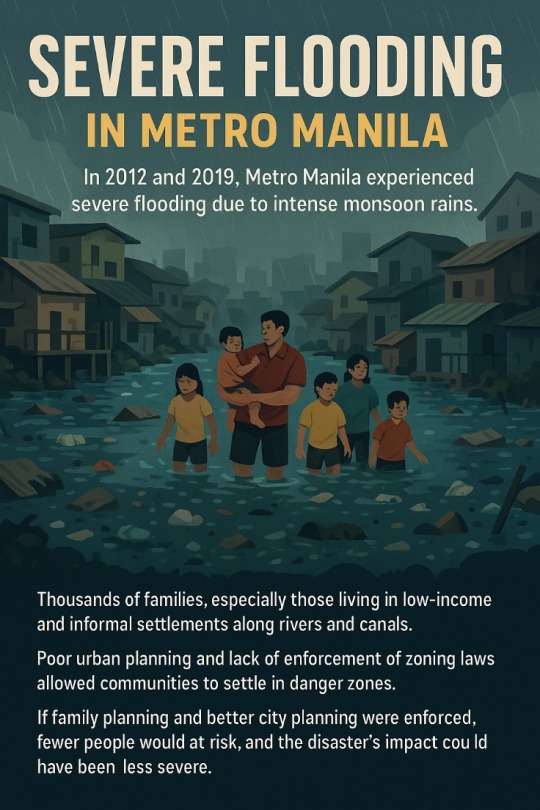
youtube
1. Understanding the Core Message
The Family Planning TVC 2014 by the Philippine Department of Health emphasizes the importance of responsible parenthood. It encourages Filipino families to plan the number and spacing of their children according to their capacity to provide. The commercial shows that proper family planning can lead to a better quality of life, reduce poverty, and help the country manage its population growth. Ultimately, it sends the message that small, well-planned families can build a stronger and more sustainable nation.
2.Social and Environmental Concerns
The commercial draws attention to several key issues such as poverty, overcrowding, lack of access to basic needs like food, shelter, and education, as well as environmental degradation. It also implies how uncontrolled population growth can lead to increased vulnerability to disasters. These problems can cause long-term effects on the health, safety, and future of families and communities.
3. The Environmental Consequences of Overpopulation
Overpopulation leads to higher demand for land, housing, and natural resources, which often results in deforestation and land conversion. In cities, it causes congestion and overuse of infrastructure, making it difficult to manage waste and drainage systems. When too many people live in one area, particularly in informal settlements, it increases the risk of flooding because waterways get blocked by garbage or illegal structures. It also contributes to air and water pollution due to the excessive generation of waste and emissions.
4. City Struggles in a Crowded Society
Cities like Metro Manila face daily challenges due to overpopulation, including heavy traffic, overcrowded schools and hospitals, and a lack of affordable housing. Many people end up living in unsafe areas, such as riverbanks and under bridges. Public utilities such as water, electricity, and waste disposal cannot keep up with the rapid population increase. This puts both the people and the environment at greater risk during times of disaster. Emergency response systems also become overwhelmed, making it difficult to help those in need during floods or typhoons.
5. How Family Planning Supports Sustainable Living
Family planning helps couples make informed choices about when and how many children to have. By reducing unplanned pregnancies, it eases the pressure on social services and the environment. With fewer people to care for, families can provide better education, nutrition, and shelter to their children. It also allows the government to better plan infrastructure and resources. In the long term, this helps create communities that are more prepared for disasters and less harmful to nature.
6. Advocate Citizen Responsibility
Citizens have a role in supporting and practicing responsible family planning. They should seek accurate information about reproductive health and use government services like health centers that offer free family planning tools. Community leaders and teachers can help raise awareness by including family planning in education. People can also take part in community clean-up drives, tree planting, and support policies that promote environmental protection and population control. Every small action contributes to a healthier society and environment.
7. Case Study: Disaster Preparedness and Population Pressure
In 2012 and again in 2019, Metro Manila experienced severe flooding due to intense monsoon rains. These floods affected thousands of families, especially those living in low-income and informal settlements along rivers and canals. The high population density in these areas made it difficult for water to drain properly because drainage systems were clogged with garbage and houses blocked waterways. Poor urban planning and lack of enforcement of zoning laws allowed communities to settle in danger zones. If family planning and better city planning were enforced, fewer people would be at risk, and the disaster’s impact could have been less severe.
References
1. Department of Health (DOH). (2014). Family Planning TVC 2014 [Video]. Republic of the Philippines – Department of Health.
https://doh.gov.ph
2. United Nations Population Fund (UNFPA). (2022). Philippines: Family planning and reproductive health.
https://philippines.unf
3. Asian Development Bank. (2020). Urban climate change resilience: A synthesis of lessons from the ACCCRN program in the Philippines.
https://www.adb.org/publications/urban-climate-change-resilience-philippines
4. Greenpeace Southeast Asia. (2020). The impact of overpopulation on the environment.
https://www.greenpeace.org/philippines
5. CNN Philippines Staff. (2019, August 5). Flooding continues to plague Metro Manila as monsoon rains persist. CNN Philippines.
https://www.cnnphilippines.com/news/2019/8/5/Metro-Manila-flooding-rain-weather.html
0 notes
Text
Manila’s Mayor Returns to Office to Face Mountains of Trash
Mayor Francisco Domagoso declared a state of emergency in the Philippine capital with piles of garbage left uncollected by contractors saying they had not been paid.
0 notes
Text
Manila’s Mayor Returns to Office to Face Mountains of Trash
Mayor Francisco Domagoso declared a state of emergency in the Philippine capital with piles of garbage left uncollected by contractors saying they had not been paid. Source link
0 notes
Text
Manila’s Mayor Returns to Office to Face Mountains of Trash
Mayor Francisco Domagoso declared a state of emergency in the Philippine capital with piles of garbage left uncollected by contractors saying they had not been paid. source https://www.nytimes.com/2025/07/04/world/asia/manila-mayor-philippines-garbage.html
0 notes
Text

𝐈𝐧𝐯𝐞𝐬𝐭 𝐰𝐢𝐬𝐞𝐥𝐲. 𝐂𝐡𝐨𝐨𝐬𝐞 𝐓𝐡𝐞 𝐄𝐫𝐢𝐧 𝐇𝐞𝐢𝐠𝐡𝐭𝐬🏙️🌟
Elevate Your Horizon at 𝐓𝐡𝐞 𝐄𝐫𝐢𝐧 𝐇𝐞𝐢𝐠𝐡𝐭𝐬. Where luxury meets convenience, and every floor is a step toward a brighter future.
𝐔𝐧𝐢𝐭𝐬 𝐀𝐯𝐚𝐢𝐥𝐚𝐛𝐥𝐞: ▫️ 𝐒𝐭𝐮𝐝𝐢𝐨 ▫️ 𝟐𝐁𝐑 ▫️ 𝟑𝐁𝐑
𝐍𝐞𝐚𝐫𝐛𝐲: 📍 UP Diliman, New Era University, Holy Family School of QC, Miriam College, Ateneo De Manila University, Diliman Hospital, General Malvar Hospital, New Era General Hospital, National Kidney & Transplant Institute, Philippine Heart Center, Veterans Memorial Medical Center, UP Technohub, UP Town Center, Trinoma, SM North, Quezon City Hall, Ninoy Aquino Parks and Wildlife Center
𝐁𝐞𝐧𝐞𝐟𝐢𝐭𝐬 𝐨𝐟 𝐓𝐎𝐃: ✅ Save time and money ✅ Better quality life ✅ Higher more stable property values ✅ Better Investment
𝐖𝐡𝐲 𝐓𝐡𝐞 𝐄𝐫𝐢𝐧 𝐇𝐞𝐢𝐠𝐡𝐭𝐬 𝐢𝐬 𝐩𝐞𝐫𝐟𝐞𝐜𝐭 𝐟𝐨𝐫 𝐭𝐡𝐞𝐦: ✅ Bigger units and generous combination of amenities and open spaces that they can enjoy. ✅ Very accessible address for everyday needs and wants (present) ✅ Nearby top universities in the country (future) ✅ Bigger units ✅ Exclusive community ✅ Best value for money option in the area ✅ Accessible to major business hubs, commercial centers, and schools ✅ Gated and secure community ✅ Exclusive address with a wide array of amenities and features ✅ Perfect for personal use, for rental, and for use of children in the future. ✅ Product and location is attractive to future lessees – Bigger unit space + TOD component + Nearness to offices and schools
𝐅𝐚𝐜𝐢𝐥𝐢𝐭𝐢𝐞𝐬 ✅ Convenience Store ✅ Card Operated Laundry ✅ Water Refilling Station ✅ High-Speed Elevators ✅ 100% Emergency Back-Up Power ✅ Property Management Office ✅ Garbage Chute ✅ Shuttle ✅ Water recycling and treatment
📩 Contact me for online presentation, sample computation, and model viewing on any DMCI Homes property 𝐋𝐢𝐥𝐲 𝐄𝐬𝐜𝐨𝐛𝐞𝐫 𝐑𝐞𝐚𝐥 𝐄𝐬𝐭𝐚𝐭𝐞 𝐀𝐬𝐬𝐨𝐜𝐢𝐚𝐭𝐞 𝟎𝟗𝟔𝟔 𝟗𝟗𝟏 𝟖𝟕𝟔𝟑
💥𝐈 𝐡𝐚𝐧𝐝𝐥𝐞 𝐚𝐥𝐥 𝐃𝐌𝐂𝐈 𝐇𝐨𝐦𝐞𝐬 𝐏𝐫𝐨𝐣𝐞𝐜𝐭𝐬 𝐏𝐫𝐞-𝐬𝐞𝐥𝐥𝐢𝐧𝐠 & 𝐑𝐅𝐎 🔎 Taguig | Pasig | Makati | Mandaluyong | Las Piñas | Parañaque | Manila | Pasay | Quezon City | San Juan, Batangas | Tuba, Benguet
0 notes
Text
1859
Have you ever read the Hunger Games series? Haven't. I watched the first movie because it was on cable TV allllll the time, but that's it. That's not to say I found it annoying though – I loved the movie and watched it til the end every time it was on! just not enough to want to read the books and watch the rest of the movies I guess.
When was the last time you ran into something? Can't remember. This doesn't really happen to me a lot.
Do you enjoy dressing up? It's fun to do when it's from time to time. I cannot imagine having to do it everyday though...seems exhausting and I would assume a money-drainer since I'd then need to buy new outfits every time lol.
Do you live in the city or a rural area? Technically counts as a province since it's outside Metro Manila, but it's not rural to the point that we'd, like, have no malls or have highways that are only 1 lane each way, which is the case for many provinces here. We still have all the amenities of a city.
Would you say you have a sense of style? Sure, but my style comes in two alter egos – I have a mood that's more preppy (halter tops, flowy short-sleeved crop tops, high-waist jeans etc), but some days I'll feel like dressing more street (XL shirts, baggy jeans, 90s-style sneakers).
What’s your biggest fear? The people closest to me dying. I'm not scared of me dying, and it's really always been more of having to learn to live life without certain people.
Have you ever been bitten by a wild animal? Nah. I've been bitten by Cooper once but that's it.
Are you close to any of your cousins? I'm very close to my eldest cousin on my mom's side; we're more like siblings than cousins at this point.
Have you ever been lost in the woods? Nope.
Where did you last travel? Our last quick vacation as a family was in Tanay for one night, then we transferred to Quezon Province for the second night.
Do you enjoy driving? If there's zero traffic, driving can be very relaxing and actually fun. Unfortunately that only happens either 1) on Sunday mornings, or 2) between 1-4 AM so I rarely get to experience it.
What song did you last listen to? To Find You from the movie Sing Street.
If you have a job, how often do you work? 8 hours a day, Mon to Fri. I prioritize work-life balance now so I don't allow myself to work weekends unless it's an absolute emergency.
What time do you normally go to sleep at night? Anywhere from 12-2 AM.
Do you watch a lot of movies? Not anymore. Somebody ruined that for me, but it's fine; I've found my peace with losing my love for movies.
Do you like Tom Petty? Not particularly.
Would you rather have snow or rain? I'm not really qualified to choose between these two.
Do you own a lot of sweaters? Nope.
Have you ever tried rock-climbing? I've never tried it before, but would like to even just once!
Ever ridden in a police car? Nope.
Favorite decade of music? I don't have one and I kind of just like bits of music from each decade.
Have any of your best friends been your best friend longer than a year? Angela will be my best friend for 19 years this 2024.
Ever witnessed a murder? Nope.
Do you care what people think of you? For the most part, no not really. I make myself likable as much as I can but if someone doesn't think nicely of me, I don't make it my problem anymore.
Does your room have a ceiling fan? It does not. I would prefer not to own one because I have a loft bed, and it would be nice to not have to worry about my head being chopped off hah.
Would you consider yourself poised? Tbh not really, I am pretty uptight and can get rattled easily hah.
Have you ever tried blogging? I did, but I was garbage at maintaining my Blogspots from before. This kind of microblogging works best for me.
Favorite television channel? I stopped having favorite channels a long time ago.
Have you ever lied under oath? No, but that's also because I've never needed to be in that situation.
What are your religious views? I don't have any; I ditched Christianity when I was 10 and have had zero regrets since.
Are you a romantic person? I am if with a partner, but I've chosen to be single so I haven't needed to whip out that side of me in years now.
When did you last change your bed sheets? A few weeks ago.
Would you consider yourself a flirt? Nah.
At what age do you plan to be married? I am no longer planning for that.
Do you eat a lot of junk food? Eh, I like to keep my diet balanced. Like yeah I have like burgers and a bunch of oily things 1-2 times a week, but I also have ~cleaner meals like salad wraps and stuff to make up for it. Middle-class Filipinos are always just one emergency away from getting bankrupt, so I'd rather play it safe especially now that I'm getting older.
When did you last go on vacation? I think our last family trip was in December, if I'm not mistaken.
Are you resilient? More than I would like to have been to begin with. People shouldn't always need to be resilient, and I have long taken issue with this concept. It makes bigger forces have an excuse to treat hardworking people like shit.
Have you ever failed a subject before? Yes, lots of times. I was never good in chemistry and advanced math, so that's why I had to work double time for the subjects I was good at to pull my averages up haha.
If so, what was the class? Oh, those two ^ then. Advanced math meaning geometry, calculus, and trig. I was never any good in physics too but I managed to play it safe for the most part, playing around the 80s in my exams.
Do you wear more bright or dull colors? More dull and neutral. Bright draws attention, and I don't want that.
Do you know anyone who has attempted suicide? Sure.
What’s your favorite quote? "If you really love to be loved, I think it'd be good to show those who love you how much you've changed." I've lived by this advice every day ever since I heard it.
Would you consider yourself mature? Sure. I still like to be petty sometimes but that's reserved for a handful of very specific situations haha.
How many clocks are in your house? Two.
Do you play any sports? Table tennis.
What is your biggest life regret? Fighting to keep a relationship up longer than it should have. So many opportunities wasted...
Have you ever been injured in a car accident? Fortunately, no.
If you could be anywhere in the world right now, where would you be? I've been getting hit with ads from Sundowners Zambales and ngl, it'd be great to be back there right now lol. It's beachside, it's quiet, VERY remote...it's the vibe I definitely need right now.
Have you ever had highlights in your hair? I haven't. I prefer getting my entire head dyed.
Favorite fast food restaurant? KFC. The problem with that is that they also have the most unsanitary restaurants :( (floor always feels – not even slippery, more of...oily?, tables always smell like wet, old towels; glasses don't always look well-washed) but ugh their chicken is so good and the Fun Shots are great and the Twister is fun to eat and they also have the best fries...it's a love-hate relationship always with KFC hah.
In what country were you born? Philippines.
Are your eyes more than one color? Nope.
Have you ever caught something on fire? Nah, I stay away from fire because this is exactly the thing I want to avoid doing.
What would you consider your biggest flaw? When I prioritize myself, I can sometimes go overboard and have borderline narcissistic tendencies.
What do you think your best quality is? I'm *very* passionate about things and people I care for.
Do you enjoy listening to others’ problems? Not in particular, I'd say? I appreciate if they trust me enough to tell me about their challenges, but it can also be pressuring. Like if they ask for advice, there's that pressure to make sure whatever comes out of my mouth is correct, or that I'm reacting appropriately.
Do you keep any plants in your house? Well, my mom does. I don't really like plants.
What is your mother’s occupation? She's a secretary in the F&B department of one of the premier hotels in the country.
Do any of your friends like your musical style? Sure. I know a bunch of people who are into K-pop.
What are you most looking forward to? My dad coming home in two weeks. Jin coming back in a month + our Vietnam trip too!
What was your favorite television show as a child? Spongebob.
Are you afraid of insects? Yes.
Are you cold-natured? I can be, especially when not in the mood.
How old were you when you got your first pet? I was around 5 or 6 when we were first allowed to take care of goldfish.
Did you / do you enjoy high school? I liked some bits, hated others (mostly the teachers).
What would you say was your favorite age? The years I was 16 (2014) and 23 (2021).
What annoys you most about social networking? The constant bickering, aka TWITTER. I have used that garbage site 200% less because all that's left there now are stan accounts who should be imprisoned with all the hate speech and death threats they spew. TOUCH GRASS
Are you the center of attention most of the time? No, and I stay away from it most of the time.
What are you currently reading? Not reading anything but the next on my list is The Midnight Library.
When did you last go to the library? Yeesh. Five years ago.
Are you ill at the moment? Yeah, I've been a bit panicky with my health recently... I had food poisoning but the side effects have been lasting a week when my past experiences have only lasted 24 hours at most, so I've been on edge. I'm still not feeling 100% confident that everything is back to normal now so I'd still consider myself ill.
Do people tease you about anything? No, not really.
How late did you stay up last night and why? 3 AM. I was playing Rhythm Hive and was working towards a goal I told myself I needed to achieve before turning in, so that's why I ended up staying up that late haha.
Have you ever written poetry? Yes. I've been revisiting it recently. All of it is trash but it's for my eyes only so it's whatevs.
Curtains or shades? Shades.
How many people have you spoken to in the last hour? Zero.
Do you tend to text a lot? Not really. I just have days where I text more than usual, but it's not consistent.
Ever lost a great best friend? Sure.
What is your favorite kind of flower? Peonies.
Do you own any guns? Never.
What would you say is your favorite book of all-time? I don't have one yet.
Do you think you’re living a good life? I am definitely more fortunate than the average Filipino.
What’s your least favorite part of the day? 5 PM - 7 PM feels loneliest for me for some reason, especially on Sundays.
Are you an over-achiever? I am a perfectionist, but I wouldn't call myself an overachiever.
Have you ever won an award for a speech? Nah.
Do you tend to curse a lot? Yes.
Have you ever played on the Ouija board? No but would love to try it for the shits and giggles.
Do you sleepwalk? I've done it once or twice as a kid, but it never happened again.
Have you ever slept on the floor before? Yes.
Are you a fan of public displays of affection? It's fine, but it becomes annoying when you start getting in the way.
When did you last attend a yard sale? Over a decade ago would be a safe guess.
Do you wish your life were simpler or more interesting? Neither. I feel like at this point of my life I've hit the perfect balance of simple yet fun from time to time; and I've also learned to stop comparing my life to those of others, especially if their lives seem more eventful than mine. If that's what they're happy with, so be it – I am also just as content with keeping my life more lowkey now.
What goals do you wish to accomplish tomorrow? Just survive the day without a client complaint, which is really the goal every work day.
When is your birthday? April 21.
Which is worse: going blind or deaf? I couldn't say, but also I feel like it's a bit inconsiderate to be like "oh having this disability would be SO AWFUL wow my life would be OVER" so casually when people with these disabilities very much exist and are living their lives every single day and I imagine them having to experience people going "man if *I* was blind I would just fucking DIE" has got to suck < Very well said. I'm in no place to assume and make comparisons.
What was the best part of today? We went out to celebrate Mother's Day and I took my family to lunch out in Barcino + I surprised my mom and grandma with roses :) I already gave my mom a pre-Mother's Day gift by getting her a shit ton of curtains a week ago lol, so I was telling both myself + my family that I might not be able to have anything planned for Mother's Day itself because I wanted to save...
Until I thought, screw it. It's my mom's day, and this only happens once a year, and money will always come back. So out to lunch we went and she got the flowers she wanted to get too.
Do you attempt to stay away from drama? Yeah. Such a waste of time. My instant reaction to drama is to resolve it, if ever I am involved.
What liquid did you last drink? Peanut butter latte.
Do you ever prefer to be alone? That is my preference these days, yes.
Have you ever had a deadly animal as a pet? Nope.
Favorite Disney movies? Toy Story 1-4 and Tangled.
Have you ever been to the beach? Many times.
If you have, how many times have you been? More times than I can count.
What was your dream occupation at age ten? I wanted to be a writer.
Are you terrified at the idea of weight-gain? No.
Do you drink a lot of water? Yes.
Does your room have carpet or hard-wood floors? Hardwood. Carpet flooring is not a practice here, unless you're in a hotel.
Do you take naps daily? Nope.
Who were you named after? My name was only inspired/lifted from someone, but I wouldn't say I was named after that person specifically – my parents knew next to nothing about said someone haha. Anyway, that person would be the singer Robyn.
Do you plan on traveling this spring or summer? We don't have your four seasons but anyway yes we have a Vietnam trip slated for June, whatever season that falls under.
Do you know anyone who is colorblind? As far as I know, no.
Have you ever been a teacher’s pet? No.
What is your absolute favorite hobby? Going to museums and watching documentaries.
How many times a day do you brush your teeth? Two.
Ever been to a tanning bed before? Nope. Don't need to.
Are you satisfied with your financial stability? I am, but it could still be better.
Who is your favorite actor / actress? Kate Winslet.
Are your nails painted? Nope.
What’s the meanest thing you’ve ever said to someone? I'm honestly not sure. I've had very mean things said to me so I've used those moments to vow to never do the same to anyone. I'm definitely very careful with the words I say, and I've even been told at work that even when I mean to be pissed, I still sound motherly lol.
Do you ever accidentally talk to inanimate objects? Yeah, especially the classic saying sorry to tables and mannequins when I walk into them haha.
What’s your favorite flavor of ice cream? OH I had this peanut butter frozen pie at a restaurant I went to recently and it was the Greatest Thing on Earth. My standard for ice cream is now ruined because of it hahah.
Have you ever kissed someone of the same gender? Yes.
Do you receive any hate mail? No, lmao.
Have you ever sent a letter in the mail? I don't think I have.
If you could, would you have a pen pal? Nope.
What color are the pants you’re wearing? White.
Have you ever had a stalker? No.
What is your life philosophy? This is directly lifted from the Genius explanation of TXT's Skipping Stones: "It is about the shift to self-acceptance when one day you will no longer be tough on yourself and instead meet yourself where you’re at."
I felt very overwhelmed when I first came across it, because it was the first time I realized that this kind of thinking resonates with me now. I was so used to hating myself and being disappointed with the person that I was, being disappointed with the progress I (thought I) was barely making – that I didn't even realize that I was slowly letting go of those tendencies and was actually unconsciously being softer with myself now. Encountering those words made me realize I am now okay with whoever I am and whatever I have achieved, and that I can just go from here.
Who last sent you a goodnight text message? Nobody.
Do you own any clothes that are your favorite color? A few, but tbh purple is not my best color so I don't plan to have a lot of purple pieces.
Have you ever been in a hot tub before? I don't think so.
What’s your favorite comedy movie? White Chicks.
In which year were you born? 1998.
0 notes
Text
Lupine Publishers | Battle Against Solid Waste: Contribution of University Belt Barangays Towards Clean and Disaster-Prepared City

Abstract
Solid waste is one of the major problems in the urban communities due to congestion and improper garbage disposal. This problem may lead to some health and disaster-related issues. University Belt Area (UBA), a congested place in Manila City, Philippines generate tons of solid waste materials daily. Given this condition, it is significant to know the response of the local government units (LGUs) in addressing this type of problem. Thus, this study investigated the solid waste management programs (SWMP) implemented by UBA barangays and its problems encountered in implementing the said programs. The awareness of the residents on SWMP and their suggestions for effective implementation of these programs were also determined. An in-depth interview was conducted among barangay officials. Small group discussion (SGD) was conducted among the selected residents. Thematic analysis was used to interpret the qualitative data while descriptive statistical tools were used to analyze the quantitative data. Findings revealed that programs implemented by ten barangays in UBA are categorized into educational, infrastructure, waste reduction, and regular cleaning activity. These programs are known to most of the residents who participated in the study. In the process of implementation, the LGUs are facing some constraints. These constraints include lack of discipline among the residents, lack of funds, irregular collection of waste materials, location of the barangay, and poor segregation practices. To effectively implement the afore-mentioned programs, the residents suggested some important recommendations. These encompass implementation of the appropriate barangay resolutions, raising public awareness, and imposition of penalties for the violators. Stakeholders should provide strong support for SWM agenda of UBA barangays. Policy makers should consider these data to formulate sound policies which can address the problems on solid waste. The barangay council should review Republic Act 9003 and consider collaboration with Ferris Wheel Project for better implementation of the programs.
Keywords: Barangays; Solid waste; Solid waste management programs; University belt area; Urbanized areas
Introduction
Every day the world is getting more urbanized. The rate of urbanization is increasing at an alarming rate. United Nations Department of Economic and Social Affairs (UNDESA) reported that 34% of the world’s total population in 1960 was living in the urban centers. In 2014, this rate increased to 54% [1]. This increase in urban population is brought by the natural increase due high fertility rate of the urban population and rapid rural to urban migration [2]. The rapid rate of migration is attributed to the pull factors inherent to the urban environment itself [3] like better job opportunities, access to health and educational facilities, and high standard of living. University Belt (U-Belt) area (Figure 1) in Manila, Philippines (Figure 2) is an area where colleges and universities are concentrated, hence the name implies. This area is the home of more than fifty higher educational institutions. The Central University Belt (CUBE) area is a seat for twenty universities and colleges. As Filipinos put a high regard for quality and responsive education, population over in this place has increased tremendously. This rise in population then is considered as contributing factors in the escalation of the amount of waste materials generated in the urban setting. According to National Solid Waste Management Commission Reports (2015). the estimated the amount of solid waste generated in 2010 in Manila City alone was 2,990,814 metric tons. In 2014, this figure increased to 3,595, 593 metric tons. There is, however, no specific information that pertains to the case of U-Belt area.
The rise in population in the U-Belt area also resulted to the emergence of additional commercial establishments, dormitories, and other infrastructure development. This infrastructure development resulted to changes in the land use and the increase in the urban surface sealing which increases the amount of surface run-off and decreases the ground water recharge [4]. This condition serves as a challenge to the Local Government Units (LGUs) on how to deal with this problem. The problems on improper waste management and high percentage of impermeable land make U-Belt area highly vulnerable to the devastating effects of flood. High amount of waste materials and improper disposal of these items make people highly prone to the diseases (National Solid Waste Management Commission Reports, 2015) [5]. From the prevailing condition of this place, the researchers came up with the framework on the goals of the implementation of solid waste management programs in U-Belt area (Figure 3). The current modified framework focuses on how the dirty, disaster-prone, and disorder U-Belt area can be converted into clean, disaster-prepared and orderly place (Figure 1). This framework was modified from the framework of Discipulo [6] on urban renewal study.
From the existing problems on solid waste management in the U-Belt area, this study investigated the contribution of the U-Belt barangays towards a clean and disaster-prepared city. Specifically, this study determined the solid waste management programs implemented by the barangays around the University Belt, identified the problems encountered by the communities pertaining to the implementation of the programs, determined the awareness of the residents in the said programs, and identified the suggestions of the residents for effective solid waste management programs implementation. Data obtained from this study is vital in policy making and urban planning of LGUs. This will also agitate the stakeholders to support and participate in the program implementation.
Materials and Methods
Research design
The research design employed both descriptive and qualitative approaches. Qualitative research aims to interpret meanings, descriptions, and symbols [7]. The goals of this type of research are to provide answers to the why’s and how’s. On the other hand, descriptive approach was used to describe characteristics of the population being studied [8]. This approach answers the question of “what” in the study. Objectives 2 and 4 were answered using qualitative approach while objective 3 was answered using descriptive method. Both qualitative and descriptive approaches were used to answer objective 1.
Research locale
The study was conducted in the U-Belt area. The name was given to this area because of the high concentration of the colleges and universities in this place. Originally, this name was given only to San Miguel district but technically it includes the nearby districts such as Quiapo, Santa Cruz. This area covers Mendiola Street, Morayta Street (now Nicanor B. Reyes Street), eastern end of Azcarraga Street (now Recto Avenue), Legarda Street, western end of España Boulevard, and the different side streets (Figure 4). This study covers the 10 barangays as given in Table 1.
Respondents of the study
The participants of the study were the 7 chairperson, 3 barangay councilors, and randomly selected residents of the ten barangays in the U-Belt Area. Ten barangay chairpersons and several barangay councilors were asked about the solid waste management programs implemented by their respective barangays and the problems they encountered during the implementation of the said program in an in-depth interview. The councilors interviewed in this study were the heads of the committee on health and sanitation. Selected residents were asked about their awareness on solid waste management programs of their respective barangays and their recommendations for effective implementation of the said programs during the small-group discussion (SGD).
Research instruments
Two research instruments were used to gather the data needed in this study. These instruments were the interview guide questions for in-depth interview and guide questions for small group discussion. The contents of these instruments were validated by the experts in the field of research and solid waste management.
Data collection procedure
In order to gather the data needed for the study, the researchers did an in-depth interview with the barangay chairpersons and barangay councilors, focus-group discussion with the randomly selected residents, and regular observation was also conducted to validate the results. The methods in the in-depth interview and small group discussion were patterned from the suggestions of Yukalang et al. [7]. The items in the questionnaires were based from the ideas of Yukalang et al. [9] and McAllister [10].
In-depth interview
An in-depth interview with eight barangay captains, 1 barangay councilor, and 1 barangay secretary was conducted by the researchers to determine the solid waste management programs implemented by the barangays around the U-Belt area and the problems encountered by the communities in the process of implementation of the said programs. The researchers prepared the guide questions for interview ahead of time. The guide questions were validated by the expert in the field of research and environmental issues and concerns. The English version of the guide questions was translated into Tagalog so that the respondents can understand better and they can freely engage in the conversation. The researchers asked permission to record the conversations from the barangay captains, barangay councilor, and barangay secretary. Field notes were also utilized to record pertinent information during the interview.
Small group discussion
Eight small group discussions were conducted during the duration of the study. The number of participants and date of discussion in the selected barangays in the U-Belt areas during the discussion are reflected in Table 1. The demographic profile of the participants such as age, occupation, and highest educational attainment were noted during the onset of the activity. Each participant was asked regarding his/her awareness about the implemented solid waste management programs in his/her barangay.
Observation
In order to counter-check the information disclosed by the barangay chairpersons and councilors, regular observations were conducted by the researchers. A weekly observation on the implementation of the solid waste management programs and the difficulties associated with the implementation of these programs was done from March to September 2017.
Data analysis procedure
After the collection of data, the data gathered were analyzed using descriptive statistical tools and thematic analysis. The quantitative data were interpreted using the descriptive statistical tools such as frequency counts and relative frequency. Meanwhile, the qualitative data were analyzed using thematic analysis. In this method, patterns or themes within data were identified, analyzed, and reported [7]. Patterns across data sets that are important to the description of a phenomenon and are associated to a specific research questions are referred as themes [11]. The themes generated from the data were validated by the experts in the field of research and solid waste management.
Results and Discussion
Solid waste management programs in the U-belt areas Results of the in-depth interview indicated that the programs implemented by ten barangays in the U-Belt areas are categorized into educational, infrastructure, waste reduction, and regular cleaning activity (Figure 5). Under educational programs, barangays implemented waste segregation campaign and information campaign. Also, they strictly imposed the “No segregation, No Collection Policy.” They also conducted the massive information campaign about proper ways of segregating of the waste materials as mandated by Republic Act 9003. Barangays are actively allotting budget for infrastructure which will counter the disaster which may be brought about by improper solid management. They have been allocating budget for repairing drainage system and constructing material recovery facilities. Material recovery facility serves as an area to store non-biodegradable materials prior to disposal.
In terms of waste reduction, barangays are now passionate in campaigning for the recycling activities. They encourage their residents to turn waste materials to raw materials for producing valuable products like lanterns and decorative stuffs. Regular cleaning activity, such as regular clean-up drive and street sweeping has been practiced by the local government units (LGUs) as a support to the solid management programs. The specific programs implemented ten barangays in the U-Belt areas is indicated in Table 2. Findings showed that out of ten barangays, seven of them, excluding barangays 395, 398 and 401 are currently implementing the clean-up drive program in their areas. Interestingly, ten barangays practice waste segregation program (Figure 6a). In addition, it was also revealed e that barangays 395, 396, 398 and 402 are implementing the Materials Recovery Facility (MRF) program (Figure 6b). Moreover, the results showed that barangays 395, 396, 397, 399 and 400 are active in implementing the information campaign program concerning the battle against solid waste. Barangay 400 is the sole barangay which is regularly doing drainage maintenance (Figure 6c). Findings also showed that all the barangays in the U-Belt are currently implementing a daily street sweeping activity (Figure 6d) in their barangays. Barangays 400 and 402 are the only barangays which are implementing the recycling activities in the University Belt (Figure 6e & Figure 6f).
Over the years rapid urbanization is taking place in Manila City, Philippines. This phenomenon was due to economic and social reasons. Consequently, the amount of waste materials generated also increases. Bernardo [12] showed that the households in the city generated an average of 3.2Kg of solid waste per day, or 0.50Kg/capita/day. In 2010, the estimated amount of solid waste generated in Manila was 2,990,814 metric tons and it increased to 3,595, 593 metrics in 2014 [4]. The existence of the different programs on solid waste management in ten barangays in the U-Belt area are the response of the various communities to the alarming problems associated with the elevating amount of solid waste generated in the congested communities. These programs are the manifestations that these barangays are abiding to the important provisions stipulated in Republic Act 9003, otherwise known as the “Philippine Ecological Solid Waste Management Act of 2000.
During the SGD, all participants were asked about their awareness on the programs implemented by the barangays in the U-Belt area on solid waste management. Findings of the investigation showed that 89% (31) of the participants are aware about the programs while 11% (4) participants are unaware (Figure 7). Generally, the results manifest that most of them have an idea about the implementation of the aforementioned programs. Awareness of the people about the programs is the outcome of the massive information drive and visibility of the infrastructure projects of the local government units. The high percentage of awareness on solid waste management programs among the residents in the U-Belt barangays is an indication that people are vigilant and participative in the programs and projects of the communities. Their participation ranges from attending the general assembly of the barangays up to abiding the proper segregation policy. On the hand, there are residents that remain not ware about the programs and policies of the barangays on solid waste management. Perhaps, they are not watchful regarding what is going to their communities and at the same time they are not participative to the activities of their barangays.
Constraints on solid waste management
Constraints encountered in the course of the implementation of every project and program makes the implementation itself very challenging. The problems encountered by the barangays in the U-belt areas in the implementation of the solid waste management programs are given in Figure 8. Findings showed that all ten barangays are currently facing the problem on the lack of discipline among the residents. They throw their garbage anywhere. They are particular of the designated places for their waste materials. Barangay 399 and Barangay 404 consider deficiency of funds as a major problem in the implementation of the program on solid waste management. Furthermore, it is also indicated above that 7 out of 10 barangays except for barangays 399, 402 and 403 are experiencing problem in terms of irregular collection of wastes. Findings also show that the barangays 395 and 397 are facing a problem on their location, which causes these barangays to produce more solid waste materials.
The constraints experienced by the U-Belt barangays in connection with the implementation of solid waste management programs in their communities are typical issues observed also in the other urbanized cities in the Philippines. For instance, Reyes & Arturo [13] observed several problems encountered by the community people in the implementation of solid waste management practices in the different barangays in Batangas City, Philippines. In their study, they found that the increasing population, inadequate government policies, public indifference (public don’t care), inefficient collection of garbage, rapid urbanization, non-operation of a good disposal facility, irresponsible government officials, lack of awareness among the people regarding the effects of solid waste management practices to their health and the environment, and lack of training on proper solid waste management practice are major barriers in implementing effective and efficient solid waste management programs.
In the developing countries however, there are constraints associated with solid waste management implementation. These constraints are categorized into culture, education, and microeconomics; infrastructure and technology; and policy, institutions, and macroeconomics [10]. In terms of culture, education, and microeconomics, the major constraints comprise the attitude and behavior gap of the people and lack of campaign on education and awareness. Major constraints under infrastructure and technology include budgetary constraints, inadequate service and operational inefficiencies, ineffective technologies and equipment inadequacy, lack of landfill disposal, and limited utilization of waste reduction activities. Under policy, institutions, and macroeconomics, the major constraints encompass lack of policy, poor enforcement and responsibility, and lack of monitoring and regulation.
Recommendations of the residents for effective implementation of solid waste programs
Some of the programs on solid waste management are not effectively implemented due to the political, educational, and socio-economic reasons. During the focus group discussion, the residents suggested some recommendations to the barangay officials for effective and efficient implementation of the solid waste management programs in the U-Belt Areas. These include implementation of the appropriate barangay resolutions, raising public awareness, and imposition of penalties for the violators.
Implementation of the appropriate barangay resolutions
One of the best strategies in order to ensure the effective implementation of the solid waste programs is to pass the appropriate barangay resolutions. The residents said that the existing resolutions are not enough to support the implementation of the aforementioned programs. Hence, the barangay council needs to pass some additional resolutions aside from “No Segregation; No Collection Policy.” These resolutions once passed should be disseminated to the general public. According to the respondents, in order for the residents to become fully aware of these resolutions, the council should ensure maximum attendance of the residents during the barangay assembly. In the era of rapid urbanization in the cities of the third world countries (e.g. Manila), appropriate policies should be implemented to address the problems associated with high urbanization growth [14]. In the case of the barangays in the U-Belt Areas, in order make solid waste management programs effective the policies and resolutions that may focus on allotting budget for the implementation of the programs, improving the linkages to the non-governmental organizations (NGOs), private sectors, and cause-oriented groups and proper spatial planning.
Raising public awareness
The success of the programs and projects on solid waste management strongly depends on the support of the stakeholders and the general public. The participation of these groups of people can be maximized if they have been properly informed. As revealed by the residents, the barangay should boost the awareness of the people through educational campaign and massive public information dissemination drive. The campaign for solid waste management programs in the U-Belt area can be disseminated well through posting in the bill boards and other public places. Campaign can be done during the barangay assembly; hence, the barangay officials should ensure the maximum attendance of the residents. Cultural and literary programs through songs and poetry can also be explored in order to boost the awareness of the people thriving in the U-Belt Area.
Imposition of penalties for the violators
According to the participants in the SGD, there is a need to impose penalties to the violators in order to make implementation of the solid waste management more effective. Violators, in the context of this study; refers to the residents who are not abiding with the policies and resolutions about management of solid waste. For instance, these people don’t dump their garbage materials in the right bins and throw their waste materials in bodies of water. Those who are doing such should be penalized by the barangay councils. The penalty could be letting them engage on community service or pay offenders can pay a certain amount of money. Community service, on the other hand, could include cleaning the public places such plaza, streets, and bodies of water and repairing of the drainage system. Imposing these types of penalties will create a culture of discipline and support among the residents.
The success of the implementation of solid waste management can be attributed by three major factors. These factors include people’s orientation and strong political leadership, strong collaboration among the different sectors of the community, mass information, education, and communication campaign, and linkage and networking with different agencies and organizations [15,16]. Mc Allister [10] considered potential interventions in order to implement solid waste management programs effectively and efficiently. These interventions include intensified education and awareness campaign, enhancement of public participation, promotion of the incentive scheme, improvements in service operations, improvements in the accessibility of the technologies, utilization of the recycling initiatives, improvements in disposal system, creation of landfill, enhancement in the funding management, and proper enactment and enforcement of the policies and programs.
Conclusion
The programs implemented by ten barangays in the U-Belt areas are categorized into educational, infrastructure, waste reduction, and regular cleaning activity. These programs are known to most residents of the area. In the process of implementation, the LGUs are facing some constraints. These constraints are: lack of discipline of among the residents: lack of funds: irregular collection of waste; location of the barangay; and lack of segregation. To effectively implement the aforementioned programs, the residents suggested some important recommendations. These include implementation of the appropriate barangay resolutions, raising public awareness, and imposition of penalties for the violators (Figure 9).
Furthermore, the concept of eco-city [17,18] should be integrated by the U-Belt barangays in their campaign for effective solid waste management programs. The idea of composting [19] in the urban setting like enzyme-enhanced compositing and vermicomposting [20-24] should also be considered for the aforementioned program. For the future research endeavor, a greater number of respondents should be considered. Hence, the entire University Belt area should be covered in the succeeding research activity. From the major findings acquired in this study, the authors came up with the extension program of SHS Department of UE Manila known as “FERRIS WHEEL PROJECT” (Figure10). It is a holistic, multi-sectoral, and multi-disciplinary project which aims to further raise the awareness of all sectors in the U-Belt community about problems associated with solid waste management. These sectors include business, youth, local government unit, academe, and people with disabilities.
For more information about Open Access Journal of Environmental and Soil Sciences please click https://lupinepublishers.com/environmental-soil-science-journal/
For more Lupine Publishers please click on below link
https://lupinepublishers.com/index.php
#lupine#lupinepublishers#lupinejournals#environmental and soil sciences#agrology#biogeochemistry#environmental science#geomicrobiology#soil fertility#soil microbiology#lupine publishers llc#environmental health#agricultural soil science
4 notes
·
View notes
Text
FEEDBACK LOOP #6: Cargo Cults’ “Rammellzee”

Since these symbols and all symbols are drawn, infinity’s separation from all symbols must be shown through drawing. The only proof of such a separation of the infinity would be the understanding by the majority of the planetary peers. There is no other way.
—from IONIC TREATISE GOTHIC FUTURISM ASSASSIN KNOWLEDGES OF THE REMANIPULATED SQUARE POINT’S ONE TO 720° TO 1440° THE RAMM-ΣLL-ZΣΣ (1979, 2003)
The rabbit-hole went straight on like a tunnel for some way, and then dipped suddenly down, so suddenly that Alice had not a moment to think about stopping herself before she found herself falling down a very deep well.
—from Lewis Carroll’s Alice in Wonderland
Riding among an exhausted busful of Negroes going on to graveyard shifts all over the city, she saw scratched on the back of a seat, shining for her in the brilliant smoky interior, the post horn with the legend DEATH. But unlike WASTE, somebody had troubled to write in, in pencil: DON’T EVER ANTAGONIZE THE HORN.
—from Thomas Pynchon’s The Crying of Lot 49
1. I walk down the street and people look at me and say, “Who the hell are you?”
Cargo Cults (Alaska and Zilla Rocca) begin their track “Rammellzee” with the voice of the some-16 billion-years-old being himself. The song is an ode, an invocation. The organ sample provides a bizarre ride: a carousel of colors. We immediately plummet—into a well, a subway tunnel, a cosmos of linguistics. Not a nonchalant That’s deep, but a depth of knowledge where “cipher” means code, means Supreme Mathematics, means gathering with your rapfolk outside the Nuyorican Poets Cafe or in Washington Square Park: a deep connection. Mimicking Rammellzee, Alaska presents the listener with “swirling pages / forming mazes of [his] formulations” and subsequently “break[s] them down into a form that’s shapeless.”

2. Hip-hop is ageist….In blues, you ain’t official until you fifty. (Ka, Red Bull Music Academy interview with Jeff Mao, 2016)
The phrase …of a certain age has, historically, been used euphemistically to describe someone (typically a woman) who has existed for a “shameful” tally of years. Society is still undoing the stigma, but rappers have made strides.
In Adult Rappers, a 2015 documentary directed by Paul Iannacchino (Hangar 18’s DJ paWL), Alaska is [accidentally?] presented twice in the closing credits—like a double, a separate persona—which calls to mind the multiple personalities of Rammellzee: Crux the Monk, Chaser the Eraser, Gash/Olear, et cetera. Age allows for maturation, for building, for bettering. In Rammellzee’s case—and I’d argue Alaska’s—it allows for complexity to emerge organically through wisdom. It allows for reinvention, for many versions of one’s self. Age and development is how an aerosol can with a fat cap can graduate to customized deodorant roll-ons and shoe polish canisters.
It begins with jerry-rigging a nozzle and ends in diagramming a “harpoonic whip launcher/pulsating extendor” to illustrate the deconstruction of letter-formations in the English alphabet. The spirit of experience pervades the Nihilist Millennial album. As anyone who has ever sat on the couch knows, communication can also improve with age.

3.
Artists and rappers like Rammellzee and Alaska rely on wild-styles, a self-made world that warps quantum physics and disregards notions of dimensionality. It’s dream-vision. It’s liberation. It simultaneously celebrates and critiques communication: like the image of a muted horn.
“Communication is the key,” cried Nefastis. “The Demon passes his data on to the sensitive, and the sensitive must reply in kind. There are untold billions of molecules in that box. The Demon collects data on each and every one. At some deep psychic level he must get through…”
“Help,” said Oedipa, “you’re not reaching me.”
“Entropy is a figure of speech, then,” sighed Nefastis, “a metaphor. It connects the world of thermodynamics to the world of information flow. The Machine uses both. The Demon makes the metaphor not only verbally graceful, but also objectively true.”
[…]
Nefastis smiled; impenetrable, calm, a believer.

The wordplay seems just that: play—that is, until you find the thread. Alaska cobbles together words like rubbish, W.A.S.T.E. Words appear daisy-chained together—flowery, ornate, and strung together by their stems: “fatalism, Fela Kuti, razor thin” / “smash the superstitions with acid tabs and some Sufi visions” / “deep dive Sonny Liston” / “Walt Whitman.”
The track reads like a codex. Something crafted in a scriptorium. His words are warfare—double-tracked/double-barreled—and he slips into braggadocio to prove it. It’s an authoritative posture of experience. Having started atomically small—from Breaking Atoms bedroom listening, to Atoms Family—Alaska’s flow presents nuclear now: maximum damage.
There’s a refinement to what this duo is doing: “Me and Zilla well-established with a lavish vision. / Both hands crusty with Ikonklastic Panzerism.” The boasts rely on royal diction: Camelot, palace doors, Prince Paul. Each man a king, a God, and each one should teach one. Mentor texts for the masses.

4.
Rammellzee is an equation, And simply stated it’s the way of life I’m chasing. That’s why I praise the future-Gothic future-prophet. Gotta rock it, don’t stop it, Gotta rock it, don’t stop.
You find diversions on the song, exits into familiar chambers. GZA quotations (“I was the thrilla in the Ali-Frazier Manila”) and allusions to Main Source. Large Professor rapped “Dead is my antonym,” and if that’s to be proven true, money needs to be removed from the equation. The refrain of “Gotta rock it” not only calls to mind “Beat Bop,” Herbie Hancock, and Grand Mixer DS.T (or his later incarnation, DXT), but rockets—Afrofuturist angles, future shocks (Bill Laswell [Material], friend to Rammellzee, had a hand in all this). It’s not so much a “future-prophet” as a “future profit.” “Freedom in the process” means creativity without expectation, without the constraints of market value.

Alaska gives it to us straight: “I don’t care if you don’t like it, and I don’t care if you don’t buy it / ’Cause I find freedom in the process.” Despite becoming increasingly complex in his visual approach—like a heap of garbage that loses the definition of its component parts over the ages—Rammellzee understood time equals clarity of vision. A wasted world becomes a meaningful one. Of course, we got to pay rent, so money connects, but ownership of one’s art is about empowerment. “Selling out” is the opposite—an evisceration of one’s self and spirit. “We lost control from the second we sold the art,” Alaska raps. “We sold our future….We should be seeking enlightenment.”
The moment arrives, epiphanically: “I find freedom in the process so I’m grateful, / And that’s my main source: it’s my friendly game of baseball.” For Alaska and Zilla Rocca, it’s not a job—it’s a passion, a pastime.
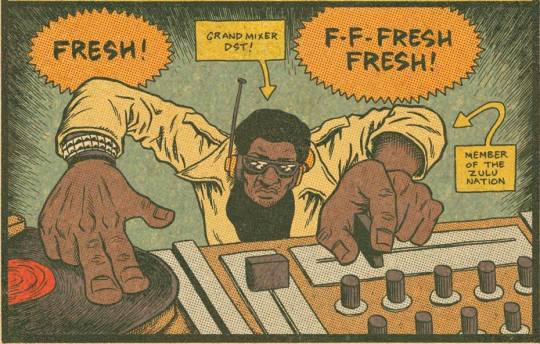
5. Nascent imagination deep inside a battle station.
Post-9/11 meant luxury apartments displaced Rammellzee’s Battle Station loft, his living museum. But the art has been excavated and exists posthumously. His Gothic Futurism and Ikonoklast Panzerism seem at home archived on the internet—a network that appears more like a chaos cloud. Rammellzee deconstructed and transcended language—junk monk scripts and calligraphic cut-ups of consumerism. His art is the empowerment a recycling arrow-triangle could only hope to be. Recycle is also rebirth. Rammellzee’s career path is circuitous, deep-tunneled (subway-esque), eternal.
Similarly, Alaska’s multisyllabic patterns are an endless barrage, like weaponized letters tilted sideways, like bottle rockets angled into a bottle’s neck: “Armament / Now my names are built like a BattleBot / Locked inside an ad hoc Camelot, I rather not / Tangle with a rabid lot, hop inside a rabbit hole.”
Alice was beginning to get very tired of sitting by her sister on the bank, and of having nothing to do: once or twice she had peeped into the book her sister was reading, but it had no pictures or conversations in it, “and what is the use of a book,” thought Alice “without pictures or conversations?”
Boredom can make trouble, but boredom can also breed creativity. Alaska rather not spar with trolls under ISP bridges—though he’s equipped to. Instead, he channels his energies into material.

6. Our culture is done. We lived it.
Near the end, Alaska paraphrases Rammellzee: “I’m not the first or the last to don the mask. / I see it as a title, I’m monastic with these raps.”
Living a life of art—making it regardless of accolade or monetary payment—is the highest form of creativity. Live the art and die by it, like Stan Brakhage, poisoning himself at a slow pace as he applied toxic dyes to celluloid film. Like Rammellzee executing graffiti pieces maskless, huffing the carcinogenic fumes.
MF DOOM (née Zev Love X)—a Rammellzee descendant—taught us how to revel in anonymity, the importance of not spotlighting yourself, but instead seeking out the shade, secret passageways, and the trapdoor in the stage floor. Not all of us heed the advice, but some do, and they feel the throb of real success, not the sort that shows up in bank statements and 401(k) plans.

Images:
“Beat Bop” test pressing, Rammellzee and K-Rob, art by Jean-Michel Basquiat, 1983 (detail) | Rammellzee black-and-white portrait photograph (unknown) | Ikonoklast Panzerism diagram from IONIC TREATISE GOTHIC FUTURISM ASSASSIN KNOWLEDGES OF THE REMANIPULATED SQUARE POINT’S ONE TO 720° TO 1440° THE RAMM-ΣLL-ZΣΣ (1979, 2003) | Page 34 (muted post horn) in Thomas Pynchon’s The Crying of Lot 49, Bantam Books edition (1966) | “A scribe at work,” from an illuminated manuscript from the Estoire del Saint Graal, France (Royal MS 14 E III c. 1315-1325 AD) | Herbie Hancock, Future Shock cassette cover (1983) | Grand Mixer D.ST comic book image (unknown) | Stan Brahage at chalkboard (unknown) | Stan Brakhage, Mothlight celluloid (1963) | “Beat Bop” test pressing, Rammellzee and K-Rob, art by Jean-Michel Basquiat, 1983 (detail)
2 notes
·
View notes
Text
Typhoon Ulyses:Another History to tell
I was on duty that time, later that afternoon I was not aware that our place Metro Manila was placed at signal #3, Heavy rain was starting to pour in,followed by strong winds, never in my imagination that this typhoon will be different.
Came 11pm I was awaken by hustling sound from the outside, the amount of Rain and Wind was scary, it was the same feeling the time we experience Super Typhoon Ondoy.
I 'am wake the whole night, restless and afraid.
By 1am electricity we're cut, honestly we thought this would only last for a few hours.
Came around 6am, electricity still unrestored, Internet connection was weak, impossible to communicate continuously. Still I thought this rain and wind will stop.
Until 8am my partner was about to go outside and purchase food items,
He was shock and came back and Flood is already knee deep, it was only 2 hours since he went outside. For this I know this typhoon is no joke.
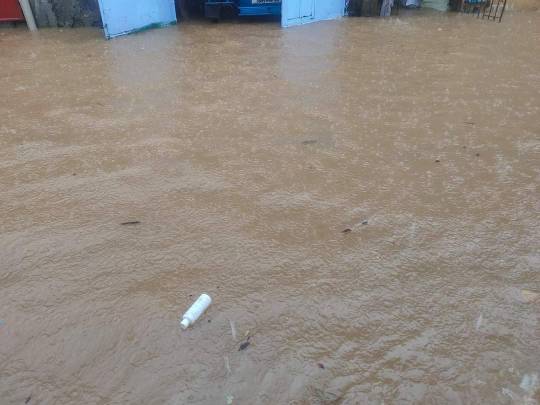
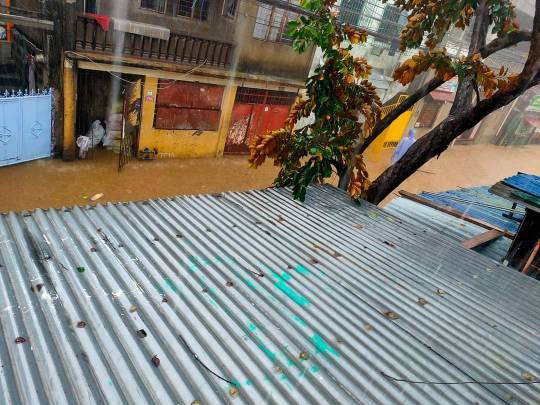
Fast forward, our electricity restored by 7pm and after we switch our television, we are lucky, other areas are heavy flooded there are casualties they lost their homes, assets and to others their loved ones.
I am thankful yet another lessoned learned,
I don't have a Emergency Kit it was a shock to me as a mother how come It never crossed my mind. (As of writing this article I am preparing also our emergency kit)
Emergency happens every time, I've made a list of emergency kit ready and what we should put on it,should disaster strike.
I've compiled and research easy emergency kit that will cost you a minimal amount and some items are ready available in your home.
This kit should last for 72 hours
1.Power Bank/Charging Device
2.First Aid Kit&Medicine
3.Multi Tool Knife/Army Knife
4.Bottled Water(1 gallon per person)
(can opener, screw driver)
5.Flashlight and Batteries
6.Ready to eat canned goods
7.Important Documents
(Birth Certificate, Bank Records, & Identification Cards)
8.Pocket Money (Cash) 1 month Salary
9.Sanitation Kit
(garbage bag, hair ties, soap, pads & towelettes)
10.Whistle
11.Water proof plastic and heavy duty duct tape
12.Lighter
13.Waterproof Container or bag
After Emergency you may need to survive for a few days. Emergency kit will serve its purpose. Preparation is one thing.
Be safe and Everyone(I'll update this post after I finish my Emergency kit also)
https://www.google.com/amp/s/www.businessinsider.com/home-emergency-kit-products%3famp
https://www.erieinsurance.com/blog/home-emergency-kit
5 notes
·
View notes
Text
Disaster Risk Reduction and Management in Barangay 471 Zone 46
Barangay: Barangay 471
Location of the Barangay: Sampaloc, Manila
Hazard Identification
The barangay that I am in is Barangay 471 Zone 46 District IV that is located in the distric of Sampaloc in the city of Manila. The barangay is composed of the streets in between Dapitan and Laon Laan namely: A. Mendoza, Santander, Juaning, Navarra, Rosarito, Asturias, and Antonito. The disasters that occurred in Barangay 471 are the typhoons Ondoy, Pedring, Sendong, and many others that all happened in the last three years. Because of the extreme force and strength of these typhoons, the city of Manila, along with my barangay, were all covered in flood. My barangay is made up of houses, commercial establishments, food stalls and different fast-food restaurants. The diasters that happens in my barangay happens yearly, for typhoons, and the minor disaster like fire happens rarely. Because of the infastructures that comprises the area, my barangay is vulnerable and exposed to fire disasters since most of the institutions and houses inside the barangay are built close to one another so in the ccurence incineration, fire will most likely flow and expand fast. Notifications from different news sites and telecasts from televised news are some of the sources of the barangay’s knowledge in incomming disasters that will happen in the near future.
Bad Community practice #1: A group of electrical wires hanged loosely near the ground

Bad Community Practice #2: A group of cars parked in front of a restaurant beside a sidewalk
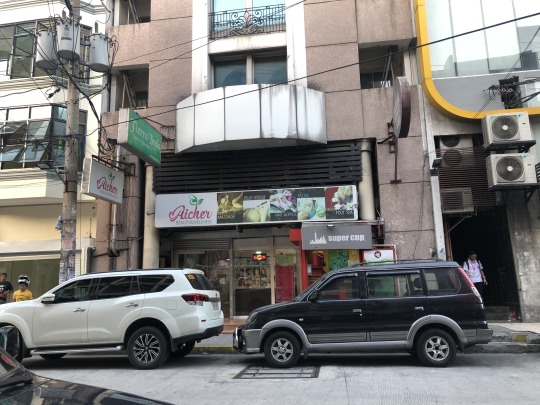
Vulnerability, Elements and People at Risk Assessment
The area in the community where there will be more damage will be the Asturias street since most of the establishment built in the area are made up of glass so the exposure and proneness to calamities are high. In case of disasters happening, the one greatly affected will be the homeless and the street children. These people do not have a permanent residence so they either sleep in the side of the streets or under the shed of restaurants and other infastructures. In the likelihood of calamity strike, street vendors and food stall vendors will be forced to stop their businesses and the public government in the area will have a hard time in managing and cleaning up the community when the calamity is done. Different infastructures will also be affected and the on-going building of some condominiums will greatly be destroyed since it’s foundation is still not that sturdy. The places that people should stay away from are establishents that are made of glass, roads that are near electric wires, and houses that are unsteady. One problem that my community face is the extreme blockage of irrigation canals due to the inappropriate disposal of garbage. The canals in the barangay are in need of de-clogging.
Safe Community Place #1: A railing separates the sidewalk from the road
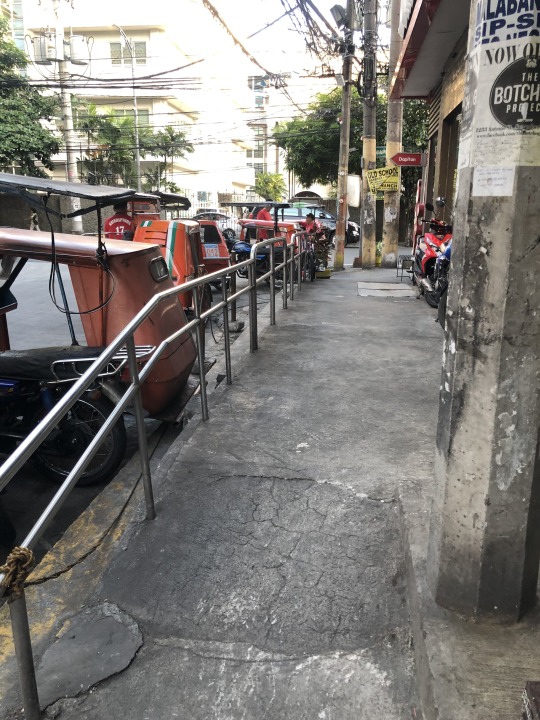
Capacity and Disaster Management Assessment
The barangay 471 has different disaster risk reduction management plans for the different types of disasters like earthquakes, fire, and typhoons. The risk reduction plan and rescue operations are led by the risk reduction council and management. The rescue operations are led by the fire brigade and the clean-up is led by the barangay captain along with the citizens. In terms of readying for impening calamities, the barangay holds earthquake drills, fire drills, and evacuation drills to physically and mentally prepare the community for the physical struggles that they may encounter if calamity strikes. The barangay also practices and uses tools like megaphones, fire extinguishers, rescue boat and the like in case of calamities. The DRRM plan of the barangay has the barangay’s map, hazard and safety map, and evacuation plans, routes, and centers. The baranagy has life boats that they use in order to rescue people from danger in their homes in case of flood, and they also use a fire truck that to respond to events involving fire. The community also help each other after every strike of disaster. The citizens, along with the barangay council conducts de-cloggong and community clean-up events to ensure the cleanliness of the community.
Good Community Practice #1: The schedule of the segregated waste collection in the community
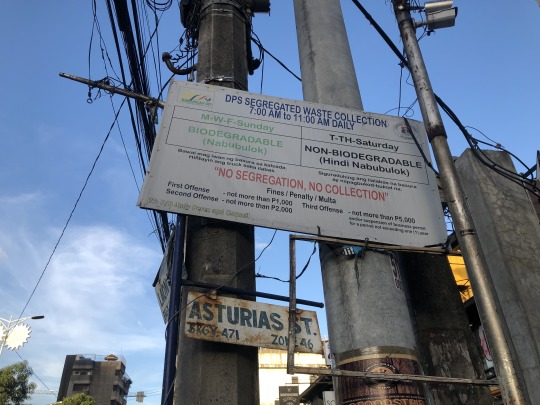
Good Community Practice #2: A sign in front of a door that indicates “no smoking”

Reflection, Synthesis, and Analysis
After conversing with the barangay official, Mr. Amado Barles, I learned about the different disasters that frequently striked my community. I also gained knowledge on how the baranagy council make and readies their disaster risk reduction and management plans, as well as the execution of these said plans. The community should continue doing earthquake drills, fire drills, and evacuation drills because it is greatly needed to physically prepare the community in case of emergencies. The people should likewise help the local barangay council in improving the community’s environment; the citizens should be held responsible for their actions since they should also be the one participating in the general cleanliness of their community. The people should know how to segregate and dispose their trash properly so that it will not add to the community’s exposure to severe flooding. All in all, the disaster risk reduction and management of Barangay 461 in Sampaloc, in the City of Manila is very informative and reliable.
A picture with the barangay official, Mr. Amado Barles

9 notes
·
View notes
Text
The Space Between Your Fingers ch 20 (end)
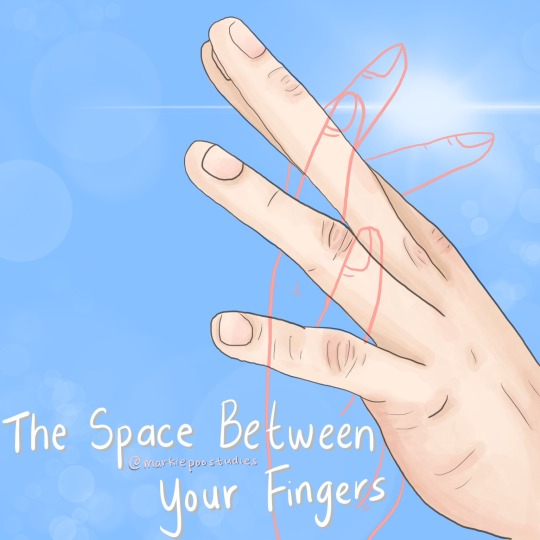
Mark Tuan x OC Genre: Fluff, angst, slice of life Words: 2.8k [Masterlist] [Series Masterlist] a/n – It’s the last chapter ahhhh! Thank you to everyone who has been following the series~ This was the series that really started it all. It’s what got me writing fanfiction again and how I started posting my writing here on tumblr and now, finally, three years later it’s finally complete! 😭💕 - [RECAP] “Time really flew by,” he spoke up softly, thumb rubbing calming against her hand. She smiled, nodding along. “It really did.” With a sigh, Mark smiled softly, looking down at the girl before him. “I guess you should go in and rest now.” She nodded quietly. Mark shifted, attempting to release his hand but Ahnmi held on, a soft but firm grip. “Mark, are we just friends?” - Ch. 20: Here Ahnmi sat between her parents, opposite a row of five girls and their parents, angry scowls on all their faces. A shiver ran across her spine as she looked at one particularly mean looking mother, her one arm held protectively around her daughter’s shoulder. When Ahnmi gulped and looked away towards the younger girl, who smirks, her nose up in the air like she has already won the battle. The truth is Ahnmi knows it too, that these five girls before her have won. More than winning—they have completely defeated her. She could still feel the stinging pain of her loss beneath the bandages on her arms.
“Okay, we’ll keep this meeting as short as possible so the students can go back to studying,” the old man between both groups said nonchalantly as he shuffled manila folders against the desk. “Of course you should,” the mean looking mother bit back, her eyes rolling in annoyance. “We don’t pay this much tuition to have our kids sit here over trivial things.” Her teeth jut out as she emphasized the last word, sneering at Ahnmi and her parents. Ahnmi could only watch as her parents cowered in their chairs and her shoulders followed suit, crumpling in submission. It was at this moment she wished her cuts had run deeper. Enough so that she wouldn’t have to be alive to witness this scene before her. Of all people, why did those girls have to be the ones to hurt her? “Let’s go over the incident quickly then. Ahnmi was found at the back of the ceramics class with fresh cuts on her arm. The cardboard cutter that was used was found in your daughter’s school bag.” “I was framed though!” The girl in the middle gasped out, immediately intertwining her arms around her mother’s. Ahnmi wondered how she could look so innocent when she had spent months making her life living hell. “There’s really no proof,” another girl spoke up. Ahnmi recognized this one to be the daughter of her father’s employer. The very man sat menacingly at the edge of the table, his eyes directly on Ahnmi’s dad. “Girls, we just want an apology,” the old teacher sighed, massaging the bridge of his nose. We want more than an apology, Ahnmi thought to herself but when she looked between the tired and scared profiles of her mom and dad, she wondered if it’s really we and not just she. “Apologize for what?” the mother asked again, scrutinizing Ahnmi before pointing to her arms. “For those cuts? Weren’t you cutting yourself before this?” All eyes zeroed in on Ahnmi and she watched as her mother sniffled. She realized then how much her mother was trembling as tears began to fall past her cheeks. “Well? Weren’t you?” the mother asked again, her tone accusing. “I-yes,” Ahnmi let out meekly, “b—” But before she could add anything else, her voice is quickly muffled by the complaints of the parents sitting across from her and so she swallowed up her remaining words until it felt like she would choke on them. Why blame us for a problem child? Why is this school even admitting sick kids in here? Will the school take responsibility if my child catches that girl’s illness? WE are the ones that want an apology! WE did not donate all this money to have this school be so incompetent! “Enough!” Ahnmi’s mother stood up from her seat, her eyes red with tears and fury. “We do not need your apologies. They are worth nothing coming from monsters anyways! I will not sit here and watch you degrade my daughter. I refuse to have her anywhere near your nasty, cruel daughters and if this is how the school will handle things, we will be taking our leave now!” “Okay, well that’s settled. The school will accept your termination of enrollment,” the old teacher let out what looked like a sigh of relief and Ahnmi watched as her mother glared in upset horror at the old man’s response. But before she could jump at the man, Ahnmi’s father was quickly ushering the two of them out. - That is the memory that flashes through Ahnmi’s mind as she sits in the student council office, between her mom and dad, across from three freshmen girls and their mothers. Between both groups are the school principal and teachers on one end and Jaebum and Jinyoung on the other end. The two boys smile at her reassuringly. She knows that things are different this time around. The three young girls hang their head low in shame and their mothers look equally as disappointed and embarrassed. She can recognize them too. One mother is the familiar owner of the convenience store they always go to. The other has a cute corgi she often walks in the neighborhood and likes to make small talk with Youngjae. The last one is the most familiar, a friend of Yugyeom’s mother who would sometimes come over for afternoon tea. Their eyes are soft and wrinkles spread across their faces in fatigue. It’s different from being in the city. Here, everyone knows each other. Here, the mothers look like her own mom and aunt. Ahnmi knows that things are different, and yet she can’t shake off the chill that keeps her hairs sticking up on end. And when Jaebum and Jinyoung smile her way, she can’t quite bring herself to smile back. “Hello everyone, thank you for meeting here today,” the principal speaks up. He is a kind, middle aged man with a big, round tummy and pink plump cheeks. However, today he is anything but jolly. His eyes are grim when they settle across the three girls. “This is an extremely severe case. The school takes bullying very seriously.” He clears his throat before continuing. “These three girls have been harassing another student, an upperclassman too, sending threats and vandalizing school property. On the day of the spring festival, these girls went further by acting on such threats and going as far as to assault a student, sending her to the emergency room.” Ahnmi closes her eyes as the incident flashes through her mind again, Mark’s desperate voice calling out for her. “This was assault and nothing less. If you girls were just a few years older, you’d have been charged as adults. And we are all aware that Ahnmi has had previous health conditions.” The principal takes a moment to quickly stare at each of the girls. “You girls are lucky you aren’t being charged for attempted murder.” Ahnmi opens her eyes again, watching as their mothers quietly gasp at the principal’s stern voice. “Due to the severity of this incident, the school administration has decided to expel the three students responsible.” At this, everyone in the room gasps. Ahnmi and her parents are taken aback as the three girls begin to break down in tears. Their mothers soon follow suite in panic. “Please, you can’t expel my daughter. Where will she go?” “Say sorry to Ahnmi quickly! What are you doing crying?” “Really?” Ahnmi’s mother quietly utters, looking to her husband with shocked, wide eyes. Ahnmi turns to the two boys in the room, but they only send her reassuring smiles. Ahnmi’s brows furrow further, an aching in her chest returning. She thinks of the haughty mother and daughter who turned their noses up at her own mother’s tears. She thinks of the terror she felt each morning, opening her locker to find it sullied with garbage and death threats. This should be her winning moment, the time for her to victory dance and laugh in the faces of her antagonists. She was supposed to feel thrilled to finally receive the justice owed to her. But instead, Ahnmi looks at the tears on the younger girls faces and the panic etched into the wrinkled skins of their mothers and she is reminded of her and her mother. “I-” Ahnmi starts softly, trying to muster up her own courage. For once though, she refuses to choke on her own words again. Instead she clears her throat. “Can I say something?” “Yes, of course, Ahnmi,” her principal answers with a gentle nod. Ahnmi looks at her father and then to her mother. They smile back softly, as if they know what she will say. “I just don’t think this is the appropriate punishment.” “Ahnmi, you were sent to the hospital,” her homeroom teacher emphasizes. Ahnmi nods but continues without wavering. “I know, but I’m still here aren’t I? It just seems too cruel to expel freshmen students from their first mistake.” “A mistake that could have killed you,” another teacher adds. Ahnmi nodded thoughtfully, but her mother quietly places her hand on Ahnmi’s back and she knows she should continue. “But the school’s way of teaching their students is to kick them out of school? That seems counterintuitive.” “What do you suggest the punishment be then?” Jaebum intervenes, a calm smile of support on his lips. Ahnmi returns the smile. “Instead of forcing students to leave without learning from their actions, maybe we could teach them. What if we had supplementary classes about bullying prevention and maybe even women empowerment?” She looked at the teachers cautiously, watching their expressions shift hesitantly. “I agree,” Jaebum added. “Instead of isolating students whether they have done right or wrong, shouldn’t we be teaching our students how to work through their conflicts?” “The student council can contribute to the development of these workshops and supplementary classes,” Jinyoung added firmly. “We should work on creating a safer environment for all the boys and girls at this school.” There is a long pause as the principal looks down at his own folded hands before he finally looks up at Ahnmi. “If this is really what you want.” Ahnmi breaks out into a smile, and so does the rest of the room as she lets out a confident, “Yes!” - It’s late afternoon when the meeting finally adjourns and Ahnmi is left in the company of Jaebum and Jinyoung. “You did great, Ahnmi,” Jaebum compliments as he leads the way back to her house. Jinyoung nods in confirmation. “Supplementary classes are a great idea. I wish I came up with that—especially having a session on women empowerment.” “Will you really be okay coming back to school with those girls though?” Jaebum asked hesitantly. She nodded, a small smile growing on her lips. “I have a feeling they won’t be doing anything anymore.” She chuckled softly, her ears blushing pink. “Besides, I think I’ve gotten stronger.” Jaebum and Jinyoung laugh along, nodding their heads. “You really have!” “Well, thanks for walking me back home guys.” “Ah, not that way,” Jinyoung ushers, blocking her off from the front gate and turning her around to Mark’s. “We’re all going this way.” The pinks of Ahnmi’s ears spreads to her cheeks as heat brims to her face. As her footsteps move closer to Mark’s house, her heart races faster. - “Mark, are we just friends?” His eyes widened at the sudden question and he immediately went red in the face, his mouth opening and closing like a fish out of water. “I-uh-w-what? I mean, um, what?” He let out an exasperated laugh at his own muttering. “Oh, ha,” Ahnmi let out an embarrassed laugh, letting go of his hand quickly. Maybe she had been reading things wrong after all. “It’s nothing, never mind.” Just as she was turning back, he grabbed hold of her hand again. “Wait, no…I-I’m just surprised.” Mark let out a breath, glancing at Yugyeom’s gate before looking back at Ahnmi. “Can we talk at my place?” She nodded quietly, feeling the burn of her face ignite again. Mark let out an exaggerated breath after placing two cold glasses of water at his kitchen table. He sunk into the chair beside her with a smile. “Okay, so you were asking me something,” Ahnmi felt her cheeks heat up again under his gaze. She put her hands to her face, trying to cool the growing warmth. “Don’t make me ask again.” Mark chuckled, enjoying the shy embarrassed look on her face. It was reassuring to know he wasn’t the only one feeling bashful. “But I forgot the question, Mi, can’t you remind me again?” he teased. She rolled her eyes, biting at the smile breaking onto her lips. “It’s just—I really like being with you…It feels different when we’re together. B-but maybe it’s just me. I like being your friend too, I just—” Mark cut her off with his laughter. With crescent eyes and a big grin on his face, he took her hand in his. “Just ask me the question Mi.” She let out a sigh, blowing at her bangs but Mark gave her hand a squeeze and it filled her with a thrill. “Are we just friends Mark?” “We are friends,” he agreed and her heart sunk. “I’d ask if you want to be more, but you’re already more to me.” Ahnmi looked up in surprise, her eyes shining with happiness. “When something bad happens, you’re the first person I want to talk to. When I see something funny, you’re the first person I want to tell. When I think about you laughing, it makes me smile. Sometimes I can’t sleep at night because I’m too excited to meet you at the gate each morning. Ever since you moved here, I’ve been so happy.” Mark grinned, seeing her expression brighten as he went on. “At first you were just this shy girl that lived next door to me, but you’re always making me surprised. And now you’ve learned how to make me shy.” Ahnmi smiled, leaning in and holding onto Mark’s thighs for support. His eyes widened, blushing at the sudden contact. “Mark, can I kiss you?” A spark of excitement ran down his spine as she leaned in, her head tilting up for him. He gulped, wetting his lips as her eyes fluttered close. He couldn’t help smiling at the way her eyes squeezed tight and the way her lips curved with happiness. Here was his whole world, surprising him once again, unfolding with her whole heart before him and he couldn’t have felt more warm and delighted than in this very moment. Leaning in slowly, he closed his eyes and let his lips meet hers. She was soft and warm and sweet, just as he imagined and he couldn’t help grinning into her kiss. Ahnmi felt herself relax as he giggled into her lips and soon the two were just teeth to teeth, smiling against each other. And it couldn’t have been a more perfect first kiss than this. - When Jinyoung opened Mark’s front door, Ahnmi walked in to find all her favorite boys gathered together in Mark’s living room. But her eyes focused on the one walking towards her, his eyes sparkling with happiness as he took her into his arms. “You did it,” Mark whispered into the nape of her neck, squeezing her tight. “See, everything worked out.” Ahnmi smiled, nodding her head and Mark couldn’t help himself, placing a sweet kiss on her forehead. The boys yelled all around them though, making her face go red again. And though Mark tried to play it off, shrugging his shoulders and intertwining her fingers in his, his ears were bright red. “Ewwwww!” Yugyeom and Bambam squealed together. “Before you guys get all mushy,” Jinyoung chuckled, pushing the two youngest away. “We have one last gift for you, Ahnmi.” “A gift?” she questioned, looking to Mark for reassurance. He winked her way, smiling with excitement. Jinyoung handed her a gift box. “From all of us.” Ahnmi felt her heart already warm, with the box in her hands and all the boys gathering around her. She didn’t need a gift honestly. She was already so happy. She was surrounded by her friends and with her favorite boy. She had everything she needed just here in this moment. “Go on, open it!” Jackson urged. Ahnmi lifted the lid of the box and her eyes watered at the sight. Inside was a school uniform and at the breast pocket was a shining gold plate with her name on it. “Finally, a uniform of your own,” Jinyoung smiled. “You’ll need it since you’re staying with us the whole way.” Ahnmi smiled brightly, the tears flowing freely now. There were no words to describe how complete she felt now. “Yeah, no more stealing hugs from us,” Mark chuckled softly. She only laughed, wrapping herself around him. “It’s okay, I can just steal real hugs from now on!” “Ewww, the mushiness has begun!” Yugyeom yelled, followed by the shouting of the other boys. And Ahnmi laughed along, her heart warming inside Mark’s embrace and she knew this would be a moment she would remember forever. This really was just the beginning, huh?
🌸🌸🌸
#got7creators#got7 reactions#got7 scenarios#mark tuan fanfic#got7 imagines#kpop scenarios#series#the space between your fingers#ch 20
57 notes
·
View notes
Text
Time and Acceptance
Title: Time and Acceptance
Pairing: erasermic
WC: 4k+
Summary:
“There is nothing you could have done to save him and…” her voice waivers here, gets softer. It’s she who breaks eye contact, looking off to the side as she says, “There’s nothing you can do to bring him back.”
Silence comes crashing down.
Something vital shifts inside Hizashi.
When Nemuri leaves, he feels these new pieces locking into place.
Notes: MAJOR CHARACTER DEATH
This is a continuation of my short ficlet, Time, which is the first part of this chapter, told in Shouta's POV. It explores Hizashi’s perspective and experiences as he grieves and tries to come to terms with Shouta's death.
Read it on ao3 here
Time and Acceptance
There’s not much time left.
Shouta watches as the concrete pressed against his cheek begins to vanish under a slowly growing veil of blood. He can’t feel the streams trickling down his cheeks any longer, doesn’t really notice the way he has lost all sensation in his limbs.
He just watches the river keep flowing out, away, reaching further and further from him.
Some foggy part of his brain feels a pull towards it, wants to go too, but he can’t focus on much beyond breathing.
He’d never thought dying would be like this.
He thought it would be violent and brutal, quick, as a villain’s sharp claws dug into his chest, or slow and painful, as he was tortured or starved for information he promised to never give.
He didn’t think it would be like this.
It was almost peaceful, almost easy. There was no part of him that hurt, physically.
His mind keeps going back home, to the safe tucked away in the back of his closet, where he’d written a Will the day he graduated U.A., and amended it the day after he’d said, “I do.”
Shouta always thought the whole concept of a Will was a little odd.
Then he’d walked out into the living room just a few weeks before his wedding to see Hizashi marking up his own. That night, the blond had said, “It’s just about the most selfless thing you’ll ever do,” when Shouta asked his fiancé for his opinions on the matter.
“A Will isn’t for you. It’s for the people you leave behind.”
Shouta lets out a ragged breath, closing his eyes.
Suddenly, all the things he’d written in that document don’t feel like enough.
He’d given it all to Hizashi, and still, in his last moments, he felt like he needed more.
He always knew he’d die alone, most underground heroes did.
He wanted to die alone, had planned to die alone, had always promised it, not wanting Hizashi to be there for this. His worst fear was to be lying in a hospital, unconscious to the world, and force his husband to make the call.
How could he put him through something like that?
Now, though, with a startling stinging in his chest, he realizes he doesn’t want that.
He wants Hizashi.
He wants to feel his lover’s fingers brushing back his hair. He wants to feel those shaking lips upon his cheek. He wants to lay there, empty, drifting into darkness as Hizashi’s tears drip onto his skin, whispering things Shouta knows he’d never be able to comprehend, not now, not so close to death.
Despite all that, he’d understand the one thing that meant the most to both of them, the one thing he’d always known, since the first time Hizashi nervously wrung his hands in his lap when they sat on the bench in the park after their classes let out and he confessed the only thing Shouta ever needed to hear.
“I love you.”
Shouta’s eyes snap open.
For a second, he stops breathing, and he thinks this must be it. He is hallucinating his husband’s voice and his lungs have stopped working.
Then he sees Hizashi’s boot disrupt the puddle of blood, splashing the red liquid as he kneels down in front of Shouta.
He opens his mouth, wants to tell Hizashi, “I love you too,” but all that comes out are coughs and a wet feeling in his throat that keeps his voice silent.
Hizashi shakes his head, lips shaking as he tries to smile around the tears flowing down his cheeks.
“I know, Sho, I know.”
Shouta feels his body moving, realizes Hizashi is picking him up, pulling Shouta into his lap. He cradles Shouta’s head against his chest and begins gently rocking him. Just like his final wish, Hizashi’s lips press against his forehead.
“It’s okay. You can go,” he says. “I’ll be okay. I’ll be okay.”
The words come out around hiccups and sobs and Shouta knows they’re all a lie, but they bring him comfort nonetheless. He hadn’t realized he’d been holding on so tight until Hizashi had said the words.
It takes all he has left to bring his hand to Hizashi’s shirt, to tighten his fingers in the fabric, to tilt his head back just enough to see his husband’s agonized face.
Hizashi does his best to give him one last smile.
As Shouta’s vision fades away, he tries to do the same.
With an odd clarity, as everything else around him disappears, he feels satisfied.
He thinks, I couldn’t have asked for a better life than this.
---
Stage 1: Denial
The legal copy of Shouta’s Last Will and Testament arrives in a manila envelope only one day after his death. The hand written, slightly crinkled copy, covered in scratched out words and rewrites as Shouta made adjustments to the document, sits tucked away behind the heavy door of their bedroom safe.
Hizashi ignores both.
He places the envelope on the kitchen island and dumps his jacket over top of it.
Sleep is a special kind of mercy.
Once safely shrouded in his fantasies, he never wants to leave. In his dreams, nothing has happened. In his dreams, the heavy weight over his shoulders is not from the comforter, but instead his husband’s arms. The warmth that comes with the morning’s sunlight streaming through the curtains and onto his face is from Shouta’s soft breaths behind him.
Waking is a special kind of hell.
Rolling over and being met with an empty space, looking over Shouta’s pillow and finding long strands of dark, wavy hair, seem to viciously juxtapose one another. The little pieces of his husband still lingering around the house tell Hizashi that Shouta isn’t gone.
The lack of grumbled good mornings, the slowly fading smell of pine wood and espresso, the padding of socked feet attached to legs too exhausted to lift them properly off the ground, all tell him that he’s wrong.
He just can’t accept it.
Over the first few days, his phone never stops going off. He silences it, but still the screen flashes bright each time he misses another call, another text. Family and friends asking if he’s okay, their lawyer asking if he’s read over the Will, the mortician asking if he’s made funeral arrangements yet, how would he like the body to appear, will it be open casket?
They don’t recommend that.
Most disgustingly, there are voicemails from media services asking for a statement.
Hizashi sends only one message to Nemuri, asking her to keep everyone away. The lack of knocks at his door say his friend is doing what he’d asked, even if he can’t bring himself to answer her inquiries into his mental and physical well being.
At some point, the phone battery dies. He doesn’t plug it in.
If Shouta were here, he’d chastise him. He’d tell Hizashi he was a hero and people might need him, what if there’s an emergency? What if something happens to one of their friends? What if a villain attack goes wrong and they need help?
What if something happens to him?
Something already did.
It’s with this thought that Hizashi finally rolls over onto his back and stares up at the ceiling, opens his mouth and says, “He’s not coming back.”
---
Stage 2: Anger
Abruptly, everything is too much.
The neighbor’s dog, who they’ve had for five years, who Hizashi had dogsat when they’d gone on vacation, walked at least a few times a month, and who had never once done anything but brought him joy each time he saw its floppy little ears, barks a few times while he is trying to distract himself with a book and his jaw locks tight. He begins grinding his teeth in time to each little yip.
Principal Nezu had told him to take as much time as he needed, said it wouldn’t even be docked from his vacation days.
When Hizashi finds himself glaring at his neighbor as they both check their mailboxes, his stuffed with condolence letters and sympathy cards to add to the growing pile in his trash, he decides he should get out of the house.
Perhaps being away from Shouta’s things will help.
Perhaps some distance will allow him the strength he needs to pick up the half drunk coffee mug sitting by the kitchen sink, left there by his husband the evening before Shouta’s last patrol.
He’s halfway through a lecture when one student raises their hand to answer a question and gets one too many simple answers wrong. His nails dig into the lectern’s sides, his shoulders slump forward. The shouted words come out as if they belong to someone else, he’s barely aware he’s saying anything at all.
Another teacher, Cementoss, he thinks, takes him by the arm and drags him out of the classroom.
He is sent home.
Nemuri tries to stop him on his way out, as he stomps his way through the halls and toward his car. She says something he can’t hear. He shrugs off her outstretched hands.
When he gets home, his eyes land on the island, on his jacket still lying over that weighty packet of paper. Within an instant, he’s across the room, throwing the garment to the floor, ripping the envelope off the counter, and stepping in front of the garbage can. He places his foot onto the pedal and the lid lifts as, simultaneously, his arm raises above his head.
He holds Shouta’s Will in the air, fist tight around it.
His shoulder tenses.
He can’t bring it down.
Tears begin to fill the trash instead.
---
Stage 3: Bargaining
It begins with one simple thought: If I had gotten there sooner, this never would have happened.
He never recovers.
Every other string of words running through his mind starts with an “if.”
If only I hadn’t let him go out that night.
If only I had gone with him.
If only I had said I love you more.
The last one is the hardest to swallow.
He can’t avoid it any longer. Responsibilities are literally knocking at his door, coming in the form of friends left unanswered for too long and his manager asking just how long he thinks he’ll be off air.
He gives half-assed lies and flips the deadbolt into place.
Nemuri, however, refuses to be kept away.
She pushes her way into the house while his mind is pushing out more “ifs.”
If only I had appreciated him more.
If only I had kissed him harder.
If only I were stronger.
She pulls him to the couch, makes him sit down. It doesn’t take much effort for anyone to drag him around these days. She only takes a small glance at the envelope, now with a ring of coffee stained into the corner and slightly crinkled around where he’d gripped it tight the other night.
“Hizashi…”
He shakes his head. Her hand comes to his knee, squeezes.
“You need to talk about this with someone. You can’t keep shutting us all out. You’re kind of scaring us, you know?”
He folds his hands together in his lap, stares down at them.
“What do you want me to say?” His voice is soft and weak. In the back of his mind he recognizes how out of place it is, how empty it sounds.
“Anything...tell me how you’re feeling...just let it out,” she says. Her voice is steady, supportive, and some part of him takes the bait.
He couldn’t keep up with the thoughts spiraling around in his mind.
“I…” he tries to start, but ends up with his teeth digging into his lower lip. Nemuri’s thumb rubs his leg in little circles.
“I just...keep thinking...I could have done more...I could have…” he trails off.
“What, Hizashi?” His mouth snaps shut at her stern tone. She sounds irritated. He hears a heavy sigh to his left, before she takes in another breath and continues, “What are you trying to say? That you could have stopped it? That if...what? You’d done something different, he...he wouldn’t be dead?”
Hizashi’s shoulders tremble as he lets out a shaky exhale.
“Listen to me,” she says, and now her hand is moving up to his face, cupping his cheek, turning him toward her.
It’s the first time he’s really looked at someone like this, one on one, straight in the eye, in what must have been weeks. It feels odd now, out of place. He feels like he can’t hold her gaze, and yet he’s too afraid to turn away.
“There is nothing you could have done to save him and…” her voice waivers here, gets softer. It’s she who breaks eye contact, looking off to the side as she says, “There’s nothing you can do to bring him back.”
Silence comes crashing down.
Something vital shifts inside Hizashi.
When Nemuri leaves, he feels these new pieces locking into place.
---
Stage 4: Depression
When Hizashi looks back on this time, he’ll remember it as both the hardest and easiest part of his grieving.
He feels nearly nothing.
Even his limbs are numb and heavy, as exhaustion settles in and never seems to leave. It’s a struggle to convince him to get up for water when his throat takes on a sandpaper-like consistency. His bones and blood and muscle and mind all have a palpable ache that only sleep seems to dampen.
In the brief moments where he’s awake, it’s difficult to put his feelings to words.
Everything has a stifling, too much quality too it.
The sound of his sheets shifting against his clothes is too much.
The small trickles of light coming in through his drawn curtains is too much.
The now nearly completely vanished scent of Shouta, barely there despite his reluctance to wash the sheets, is too much.
It’s on the third or fourth day, he’s lost count really, that he feels something different, that he feels anything at all.
His mind shifts gears, goes wandering back to Nemuri’s words.
There’s nothing you can do to bring him back.
He feels helpless.
He is a hero without a purpose, unable to save the only person who ever mattered.
His eyelids slide down. He descends into slumber once again.
Each time he awakens, he hears her voice in his head. Over and over, tinged with a lonely sadness that penetrates every part of him, and mixing with the static.
At some point, among all of these chaotic thoughts, the image of Shouta’s Will, still sitting on the kitchen island, interrupts, brings the whole chorus to a halt.
There’s nothing you can do to bring him back.
For the first time since nearly throwing that envelope into the trash, tears begin falling down his cheeks and soaking into the pillow case below him.
There’s nothing you can do, Hizashi thinks. There’s nothing you can do for him.
So do something for yourself.
---
Stage 5: Acceptance
It starts with opening the curtains all the way, something he hadn’t done in weeks. His hands shake when he grips the fabric and pulls, but when the light finally touches the bed, bounces off the mirror propped against the corner wall, he finds his feet moving.
He grabs the black, silk robe off the back of the bedroom door and slips his arms in, tying the belt loosely around his waist. This too feels like progress, something small, but something more than he’d had the energy to do lately.
Stepping out into the hallway takes a bit more out of him, but he doesn’t let the momentum fade. He knows if he pauses, he’ll never make it to his goal. So he continues on, refusing to look away from the end of the hall, forcing his feet to slide across the carpet until they meet the smooth tile of the kitchen.
He pushes himself toward the island.
Here, though, he has no choice but to stop.
With the loss of movement, he begins to waiver.
Staring down at the envelope that had plagued every corner of his mind that Shouta’s death wasn’t already occupying, he fights back the urge to begin biting at his lip again. It’s already raw from the previous night spent crying into his sheets.
He takes a deep sigh, like air could somehow help bring his hand up from where it is tucked against his chest, arms crossed over him protectively. He holds it in, closes his eyes.
He sees Shouta, sitting on the living room floor, hunched over the kotatsu, pencil in hand, as he scribbles onto a pad of paper. He remembers watching his husband’s reading glasses sliding down his nose, how his hand rose lazily up to push them back into their place. He’d plopped down on the floor behind Shouta and lay across his back, peeked over his shoulder, and asked, “Giving me anything good?”
It had been a joke.
All heroes die, but he hadn’t really considered it, not in that moment, anyway, not for Shouta.
His husband had nudged him away and told him if he kept trying to find out, he wouldn’t leave Hizashi anything but the piece of paper the Will was written on.
He’d laughed, they both had.
Now, he exhales.
He opens his eyes.
He reaches out and picks up the envelope, sliding his finger under the seal and tearing it open. He pulls out the small packet, letting the envelope fall to the counter as his hands begin to shake.
The first page is a neatly typed note from their lawyer. It says that the packet contains a letter from Shouta, and that the rest was his Last Will and Testament. She gives her condolences. She gives her contact information. She says she’ll be in touch to help him settle his new finances, and to help him update his own Will.
Ah, yes, he’d forgotten about that.
He’d have to give his possessions to someone else now.
He’d never thought about a world where Shouta died first.
Setting the lawyer’s note down onto the counter is perhaps the hardest thing he has ever had to do.
He takes the rest of the packet into the living room, sitting down on the couch, right in front of the spot where Shouta had written it all those years ago.
Finally, Hizashi looks down. He begins to read.
The greeting is crossed out several times, finally starting with just:
Hizashi,
Like most intimate things, I’m off to a bad start here. I’m not sure how I’m supposed to begin a letter to my husband, knowing you’ll read it after I’ve died. It’s hard to think about that. Not so much dying, I know it will happen, but picturing you...alone in our house...shit, you’d hate it. I know you must hate it. I’m…
The word “sorry” is crossed out. Hizashi’s hands increase their tremble.
I don’t think I’ll have died doing anything I regret. I hope it’s during hero work, or I hope it’s when I’m old, retired, lying in a bed with you.
You know, I never used to think about that. I never thought about dying in my sleep. I never thought about making it passed my 40s, really. I hadn’t even made a Will until I fell in love with you. Now, nothing I have seems like it could ever be enough. If you get this when I’m old, I hope I’ve acquired more than just some money, a cat, and a sleeping bag. I hope I saved something good for you. I hope it makes you happy.
I hope you’re alright.
I know you’re a mess. I know you’ve probably been crying for days. I know you’ve probably locked out all our friends and family. I hope you’ve remembered to feed the cats...and yourself...at least.
It’s okay if you didn’t, though. It’s okay to take time. Take as much as you need. I sure as hell took my time telling you I loved you, confessing to you, and I hope I took my time leaving you.
If I didn’t, please know that you were in my last thoughts, I’m sure. Please know that you were the best thing to ever happen to me.
You see, Hizashi, the funny thing about writing this will is that you’re suppose to give up the most important things in your life to someone you love, but…
You’re the most important thing in my life.
The paper crinkles in Hizashi’s hands, as his grip tightens around the page. His teeth are digging into his lip. He sniffles, tears gathering along his bottom lid.
You once told me that writing a Will is one of the most selfless things we ever do. You told me that we don’t write them for ourselves, we write them for other people.
I wish that I could be there to help you. I wish that I could give you so much more than this stupid letter.
I want you to know that it’s okay if you want to get rid of my things. It’s okay to wash my clothes, to throw out the sleeping bag, to take down our pictures for a while, whatever you need to heal, it’s okay. I understand.
I also understand if you move on.
You were the love of my life, Hizashi. After that is over, it’s okay if you have more people to love. I want you to surround yourself with people and things that make you happy. I want you to fill what remains of your life with happiness and warm memories, because that’s all you’ve ever filled mine with. If I’m not there to share in them, I hope you will experience them for both of us.
I know you won’t forget me.
I know you loved me.
I know you’ve probably got an equally as sappy letter sitting in that safe beside mine.
I’m not a religious man, Hizashi, but I pray to God I never get the chance to read it.
It’s so hard to wrap this up...you know...the end of the page is coming up here and I still feel like I have so much more to say. I can’t possibly find a way to end this. How could I? I’m still alive. How am I supposed to know what I want to say to you when I’m dead? I hope I’ll have said everything to you already when I’m still there with you.
I’m rambling now, something I must have picked up from you, no doubt.
I guess that’s a good place to end...thank you, Hizashi. You changed me so much. You made me softer, kinder. You made me more honest. You made me take risks, talk about how I feel, and more importantly, made me care about myself more.
Hizashi, I knew the day I became an underground hero that I would die young.
You made me want to live.
I love you. I love you more than I could ever write here. You were everything that ever mattered.
I know this is hard. I know you’re upset. I know. I know.
But you are strong. You’ll be okay.
Goodbye, Hizashi.
Keep going, for me.
Love, your husband,
Aizawa Shouta
It takes a long time to put the letter down. It takes a long time for the sobs to cease. Briefly, he feels like he’s back at square one. Curled up on his side, face pressed into the couch cushion, he feels like he’s made no progress at all.
When his eyes have finally dried, he looks to where he’d placed the Will and letter on the ground. He stares at Shouta’s handwriting, stares at those few words:
Keep going, for me.
“Okay,” he whispers.
Hizashi pushes himself into a sitting position, picking up the packet which will outline all the physical things Shouta has left behind.
He knows this won’t hurt as bad, that he’s gotten through the hard part.
He can do this.
For him.
For Shouta.
He can do this.
#erasermic#maizawa#erasermic fanfiction#aizawa shouta#yamada hizashi#present mic#eraserhead#bnha#mha
112 notes
·
View notes
Text
I was fortunate enough to be given a chance to conduct a brief interview about DRRM with an official of Barangay 471 located at Dapitan side of University of Santo Tomas, Manila. Actually, I permanently reside in Marikina City but due to some constraints I chose to conduct the interview here in Manila. Also, since I am a transient resident in the area, I realized that I should be more aware of the hazards, disasters and their programs and plans about Disaster Risk and Reduction Management to further enhance my knowledge and at the same time, ensure my safety.
LOCATION:

Brgy. 471 is one of the one hundred and ninety two (192) barangays situated in the district of sampaloc in the City of Manila. The barangay population is composed of 1,872 residents with 11 Tanod, 12 Lupon, 1 Street Sweeper and 1 Health Worker serving the people.
It is composed of the streets of Antonio, Asturias, Rosario, Navarra, Juaning, Santander and a portion of Dapitan and Laon-Laan. The Barangay is considered as a transient area for students and pedestrians as it is situation near school and maintain transportation routes.
INTERVIEW PROPER:
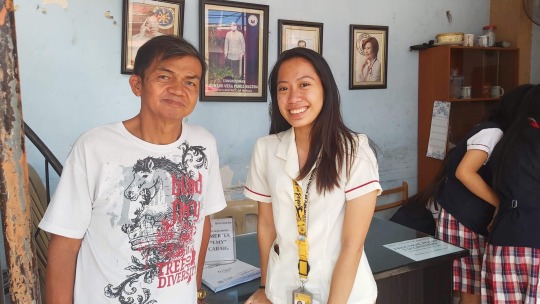
I was given a chance to interview, Mr. Amando Barlez, a tanod in Brgy. 471. During that time, the Barangay Captain and other Kagawads are not available but Mr. Barlez willingly accepted my request to conduct my interview about BDDRM. He showed me their reports and plans for Disaster Risk and Reduction Management, their equipment, Earthquake drills, and their projects that help make the community more safe. As he showed the reports, he patiently explains them to be able to ensure that I understand it. During our interview, some students encountered a snatcher and Tanods willingly help them by checking the whole area, checking the cctv and they ought to do their best to help the students. This event implied that even there are bad circumstances and hazards in the barangay, officials are always willing to help and ensure the safety of the people.
DISASTERS:
What Barangay 476 experience the most is flooding. We can't deny that in Manila, heavy downpour of rain or just a long rainy day can submerged a lot of roads and streets. Even just regular monsoon rains can cause the streets to be flooded at least 6 inches. The roads that are greatly affected by flooding are Dapitan and Laon-Laan. These interferes with the lives of the people and it can bring a lot of diseases and other possible disasters. According to Mr. Abalez, fires aren't that much around the area but countless fire prevention seminars and fire drills that the people in the community undergo regularly through their respective schools and workplaces and even in the barangay. He also stated that minor earthquakes occur every now and then.
There are two schools in the area, University of Santo Tomas and Perpetual Help College- Manila, students and workers are the groups of people that will be most affected by these calamities according to him. During times of typhoons, students would not be able to get a ride to school and the workers would have a hard time getting into their workplaces.
“There is a need to address the vulnerability of natural resources to climate change to ensure sustainable economic growth. We lost an average of our GDP to damage caused by extreme events (Ondoy, Pedring, Quiel, Sendong, etc.).”
During the course of typhoons, barangay officials are on full alert and are ready to assist. Tanods are monitoring and roving around areas of jurisdiction.
Safe Places:
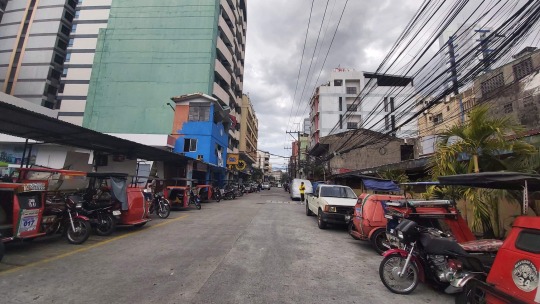
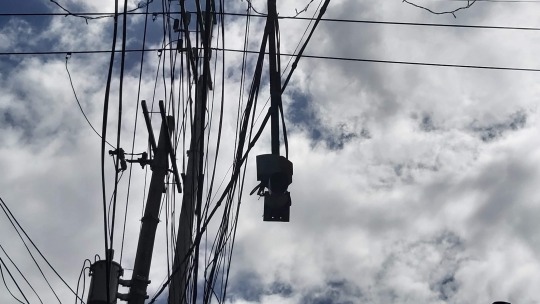
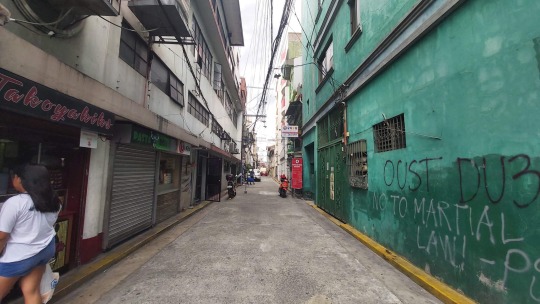
One of the safe places is the street where the Barangay Hall is located. It also serves as an evacuation in times of emergency. Streets are equipped with cctv cameras that enables the officials and workers of the barangay to track the happenings around the area and to ensure the safety of the people.
HAZARDS:
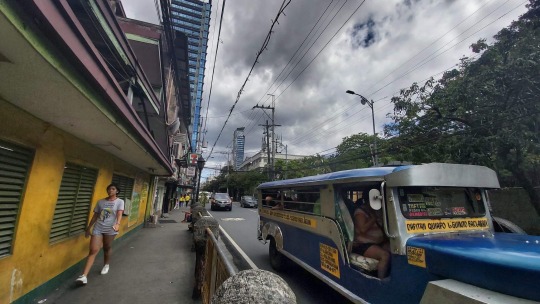
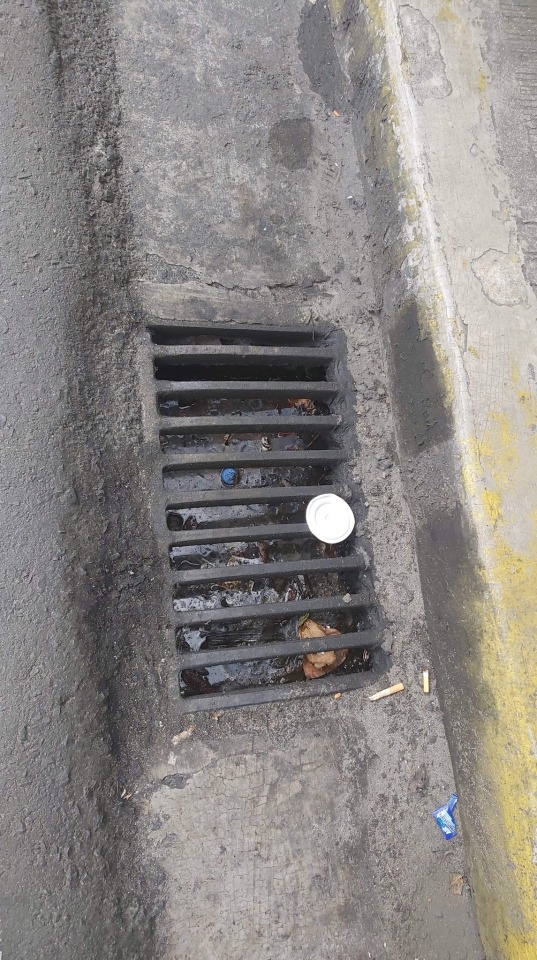
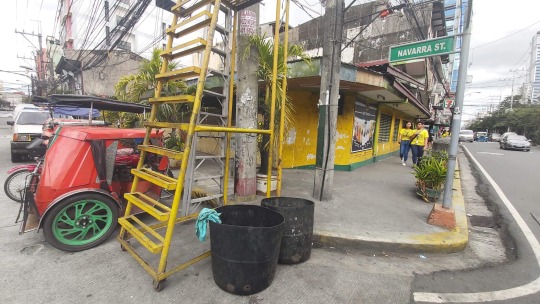
Improper disposal of garbage, clogged canals, cables and the main road are considered hazards for it can cause damage and disasters.
GOOD PRACTICES:

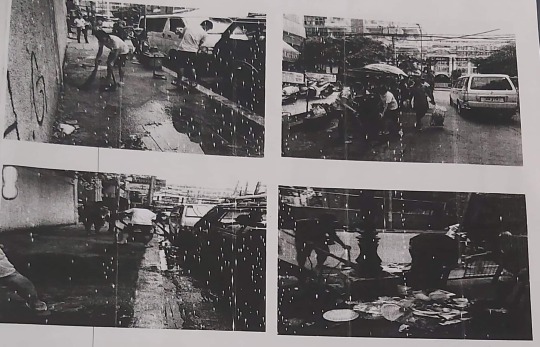
Declogging of canals and clean-up drive are being done to reduce hazards that can lead to flooding.
Seminars and trainings are being done with University of Santo Tomas and Raha Fire Volunteers to improve knowledge about disasters, first aid and Disaster Risk Management. They also educate the community about precautionary measures and to be always ready in case a disaster happens. The Barangay is also equipped with various equipments ready at all times during any disaster/ rescue operations.
The Barangay Officials and their BDRRM plans are organized for the officials are divided into teams to act on different scenarios and each is headed by a Kagawad. Some of their teams and functions are:
Disaster Coordinating Council - coordinates arrangements for and directs all drills and plan
Rescue and Evacuation Service Team - plans movement and establishes movement procedures to give effect to the evacuation plan
Medical Service Team - responsible for training and educating all personnel assigned to perform medical and first aid services in an emergency
Fire Brigade Team - working closely with the dwellers or residents on matter of fire prevention and protection
Damage Control Team - responsible for controlling utilities in the community during an emergency and assess damages inflicted in various areas of the barangay
With the short interview with Mr. Barlez, I realized that the barangay really has plans about BDRRM but I hope that in the event of a disaster, their plans will be executed. I believe that educating people and learning all their plans will help the community be more ready to face any disaster. This will be their road to safety for it will enable each person to enhance their skills and knowledge that will be really essential during times of disaster. In this way, I could also be a key to others for I have gained enough knowledge to spread awareness not only in UST, but also around different barangays. This made me realize that people should also have the initiative to know about the DRRM of their barangay and to know the hazards so that each one of us can act towards securing the safety of all and towards improving the situations in the community.
2 notes
·
View notes
Text

𝐈𝐧𝐯𝐞𝐬𝐭 𝐰𝐢𝐬𝐞𝐥𝐲. 𝐂𝐡𝐨𝐨𝐬𝐞 𝐓𝐡𝐞 𝐄𝐫𝐢𝐧 𝐇𝐞𝐢𝐠𝐡𝐭𝐬🏙️🌟
Elevate Your Horizon at 𝐓𝐡𝐞 𝐄𝐫𝐢𝐧 𝐇𝐞𝐢𝐠𝐡𝐭𝐬. Where luxury meets convenience, and every floor is a step toward a brighter future.
𝐔𝐧𝐢𝐭𝐬 𝐀𝐯𝐚𝐢𝐥𝐚𝐛𝐥𝐞: ▫️ 𝐒𝐭𝐮𝐝𝐢𝐨 (28.50sqm to 32.50sqm) ▫️ 𝟐𝐁𝐑 (48.50sqm to 117sqm) ▫️ 𝟑𝐁𝐑 (76.50sqm to 236.50sqm)
𝐍𝐞𝐚𝐫𝐛𝐲: 📍 UP Diliman, New Era University, Holy Family School of QC, Miriam College, Ateneo De Manila University, Diliman Hospital, General Malvar Hospital, New Era General Hospital, National Kidney & Transplant Institute, Philippine Heart Center, Veterans Memorial Medical Center, UP Technohub, UP Town Center, Trinoma, SM North, Quezon City Hall, Ninoy Aquino Parks and Wildlife Center
𝐁𝐞𝐧𝐞𝐟𝐢𝐭𝐬 𝐨𝐟 𝐓𝐎𝐃: ✅ Save time and money ✅ Better quality life ✅ Higher more stable property values ✅ Better Investment
𝐖𝐡𝐲 𝐓𝐡𝐞 𝐄𝐫𝐢𝐧 𝐇𝐞𝐢𝐠𝐡𝐭𝐬 𝐢𝐬 𝐩𝐞𝐫𝐟𝐞𝐜𝐭 𝐟𝐨𝐫 𝐭𝐡𝐞𝐦: ✅ Bigger units and generous combination of amenities and open spaces that they can enjoy. ✅ Very accessible address for everyday needs and wants (present) ✅ Nearby top universities in the country (future) ✅ Bigger units ✅ Exclusive community ✅ Best value for money option in the area ✅ Accessible to major business hubs, commercial centers, and schools ✅ Gated and secure community ✅ Exclusive address with a wide array of amenities and features ✅ Perfect for personal use, for rental, and for use of children in the future. ✅ Product and location is attractive to future lessees – Bigger unit space + TOD component + Nearness to offices and schools
𝐅𝐚𝐜𝐢𝐥𝐢𝐭𝐢𝐞𝐬 ✅ Convenience Store ✅ Card Operated Laundry ✅ Water Refilling Station ✅ High-Speed Elevators ✅ 100% Emergency Back-Up Power ✅ Property Management Office ✅ Garbage Chute ✅ Shuttle ✅ Water recycling and treatment
📩 Contact me for online presentation, sample computation, and model viewing on any DMCI Homes property 𝐋𝐢𝐥𝐲 𝐄𝐬𝐜𝐨𝐛𝐞𝐫 𝐑𝐞𝐚𝐥 𝐄𝐬𝐭𝐚𝐭𝐞 𝐀𝐬𝐬𝐨𝐜𝐢𝐚𝐭𝐞 𝟎𝟗𝟔𝟔 𝟗𝟗𝟏 𝟖𝟕𝟔𝟑
💥𝐈 𝐡𝐚𝐧𝐝𝐥𝐞 𝐚𝐥𝐥 𝐃𝐌𝐂𝐈 𝐇𝐨𝐦𝐞𝐬 𝐏𝐫𝐨𝐣𝐞𝐜𝐭𝐬 𝐏𝐫𝐞-𝐬𝐞𝐥𝐥𝐢𝐧𝐠 & 𝐑𝐅𝐎 🔎 Taguig | Pasig | Makati | Mandaluyong | Las Piñas | Parañaque | Manila | Pasay | Quezon City | San Juan, Batangas | Tuba, Benguet
0 notes
Text
B A R A N G A Y K U W E N T U H A N
T H R O U G H T H E L O O K I N G G L A S S : An Exploration Into Our Own Communities
By: Cristina Paula E. Castro

In the time of expansion, it had become easy for us to overlook our very own locales when we discuss about society. Today, we tend to look at the Macro Perspective of things without considering the smaller components that make it up. As we analyze the society in a global perspective and national perspective, it is important for us to also look into the tiny communities that make up our kaleidoscopic world. This is precisely what the University of Santo Tomas’ National Service Training Program enables students to do.
In a task to interview barangay officials about the hazards, vulnerabilities, capacities, and risk reduction abilities of the community, I was able to interview Mr. Marco Dan C. Salvaña and Mr. Fernando D. Concan about the conditions of Barangay San Isidro.
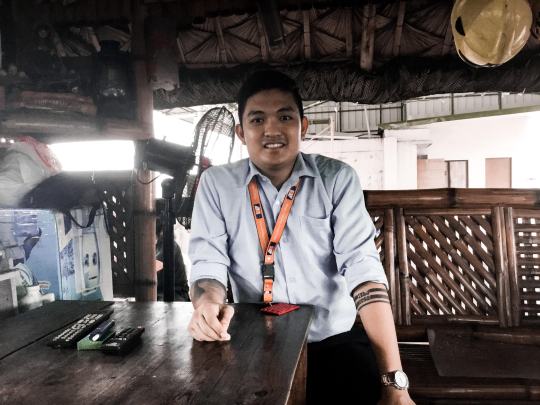
Shown in the photographs are Mr. Marco Dan C. Salvaña and Mr. Fernando D. Concan.

The interview began with the simple identification of the existing hazards for the community. Mr. Salvaña had identified two of the top hazards that threaten the community; fire and flood.

Mr. Fernando D. Concan signs the letter of consent.

Below is a photograph during the interview. Unfortunately, Rm. Marco Dan C. Salvaña requested not to be shown in the photograph on the day of the interview itself as discretion because he was in his school uniform.
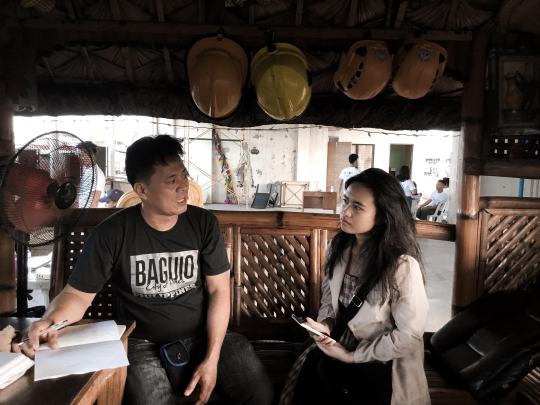
While Barangay San Isidro sits in a heavily urbanized city, there are still portions of the barangay with less developed housing. With fire being unpredictable, it poses a huge threat to every area, especially those of which are compounds with houses and establishments made of light materials. The barangay has specific areas such as the Silverio Compound and the creek side of Valley 02 which are populated by informal settlers. As the houses and buildings were not planned with as much care as the other infrastructures within the barangay, fire easily spreads throughout these parts of the community. Earlier this year, a large fire consumed a commercial hardware establishment which is largely constructed with flammable materials. As a result, the whole area that it covers was consumed by fire. In the previous years, small fires that spark within Silverio Compound, Barangay Village, and the border near Santo Niño have created a great damage to the community due to the fast growing of the fire and due to the unpreparedness of the community during that time. Today, the Disaster and Risk Management Division of the barangay considers fire as the number one hazard to the community.
Unlike other phenomena, typhoons and rainstorm are largely predictable. Because of this, flooding has become less threatening for the barangay and disasters due to natural phenomena has become less frequent throughout the years. Still, the improve canal systems are only partly effective in alleviating this problem in certain areas. Although the city is situated in flat land, certain areas have been constructed with uneven roadwork and are located in lower land areas. Such places include Lopez Village, Vitalez Compound, and Matatdo Homes. Apart from this, there are also small bodies of water within the barangay. During the wet season, these bodies of water overflow and cause light flooding to sever flooding in the areas surrounding it. Such creeks include the inner part of Valley 02, the creek in the main road of Greenheights Village, and the lower part of Matatdo Homes.
Apart from these two hazards, the barangay also considers the possibility of an earthquake as a major hazard. While the barangay is not situated on the Marikina Valley Fault System which runs through Metro Manila, the barangay maintains serious earthquake preparedness as the city itself is situated near the areas along the fault line. Large structures such as the express way, abandoned buildings which have not been retrofitted, unfinished buildings, and newly constructed buildings may collapse during a strong earthquake. Apart from damaging its surrounding structures, it may also be a direct cause of the loss of life of the people. Such is observed in the neighboring barangay, Barangay Tambo.
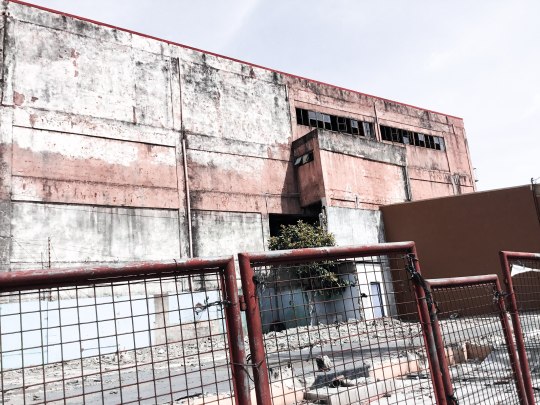
Here are some of the photographs of abandoned and unfinished infrastructures found within the barangay.
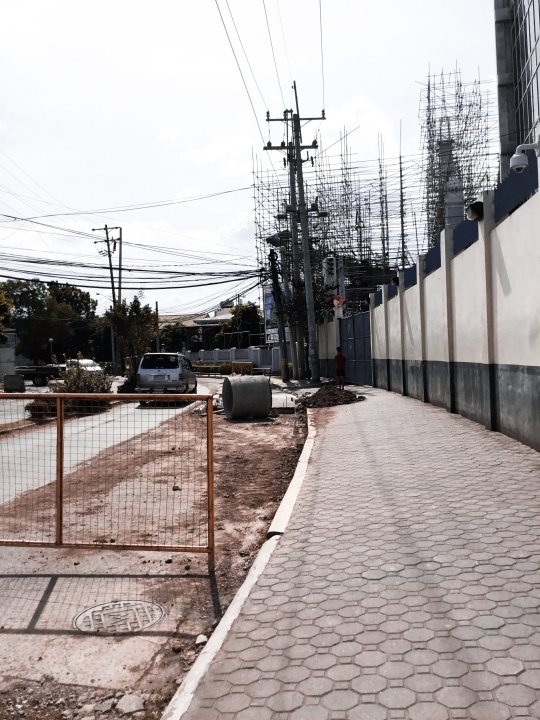
Mr. Concan has mentioned that these hazards and risks are reviewed quarterly by the division, headed by the barangay chairman, Capt. Noel J. Haplos. While the division team is responsible for most of the operations, the projects are often proposed and organized by the barangay chairman as he is the one who coordinates with the neighboring barangays about the affairs of the community.
Prior to the heightened involvement of the people in the community in disaster management, the barangay was focused on the response to disaster alone. However, as more youth organizations sprouted along the line, the barangay was able to coordinate with these associations to educate the capable members of the society on how to prevent, prepare, and respond to a disaster. In the unfortunate instances wherein disasters and calamities caused a devastating impact, the division is only able to respond to select areas at a time due to blocked roads and disrupted signals. After a brief recovery period, the disaster team tasks individuals to gauge the damage caused to the community, its probable root cause, and how to address the said problem. Since then, the barangay, in coordination with the city, was able to improve waterways, acquire appropriate weather instruments, develop evacuation plans for the different sub-areas of the barangay, and distribute necessary items during emergencies and during calamities.
The community walk enabled me to see first-hand the key places within the barangay. We were able to visit the most hazardous places or the areas which are most likely to acquire the most damage in times of disaster.
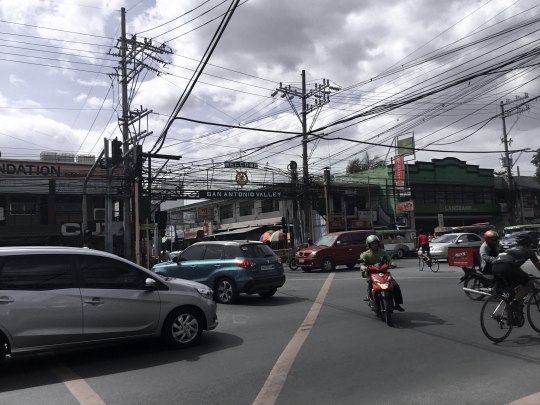
Shown above is the entrance to San Antonio Valley 02.

Pictured above is the entrance to Silverio Compound, and below is a snapshot of the area.

For fires, the areas that are most susceptible to this hazard are Valley 02, Silverio Compound, and Barangay Village. There are large portions of Valley 02 with infrastructures that are very closely built. There are also less-developed portions in the compound with homes that are built with substandard materials. Silverio Compound, which lies near the barangay hall, is a relatively large area occupied by informal settlers. Because of this, the landscape of the compound is poorly planned with narrow roads, overlapping houses, and poor street system. In addition, the houses that populate the area are pre-dominantly made of thin wood planks and metal gals. During instances of fire, the fire department of the barangay finds it difficult to respond as soon as possible due to the narrow labyrinthine streets which block fire trucks from entering the compound. It is also doubly challenging to extinguish fires as the houses are stacked against and atop other houses. Barangay Village also houses an area of poorly-constructed homes that are compressed in a small land area. Because of this, it becomes difficult to trace the exact place from where fires specifically spark. The damage is also more fatal as the fire easily spreads in the small area which houses a large number of people.
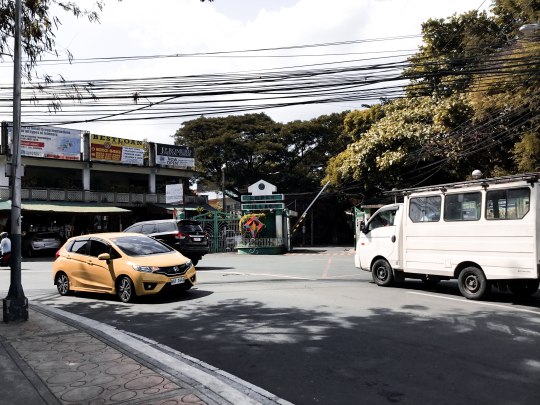
Shown above is the entrance to Lopez Village. Entering the village is not possible during the time of the community walk as non-residents are not allowed to enter the premises without a letter from a homeowner.
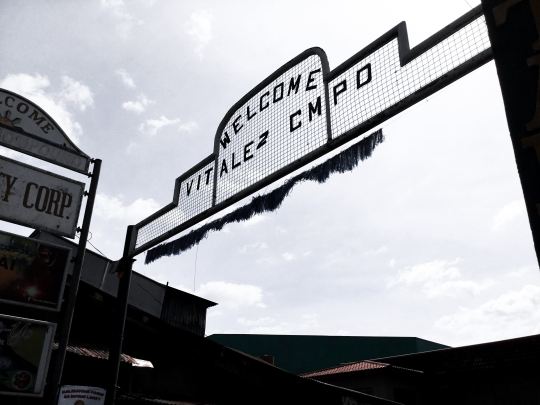
Pictured above and below is the entrance to Vitalez Compound.
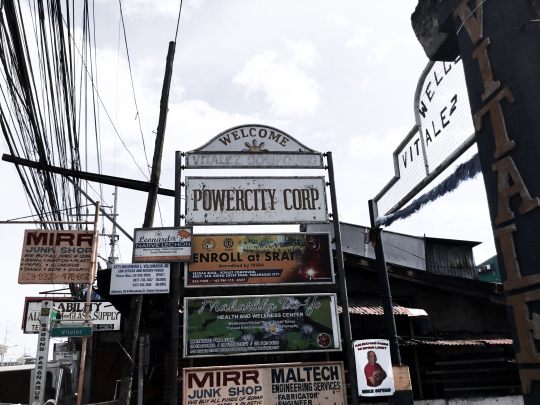
Pictured below is the downward slope of a street in Vitalez Compund.

The uneven ground level in Vitalez Compound is one of the reasons why it is susceptible to flooding.
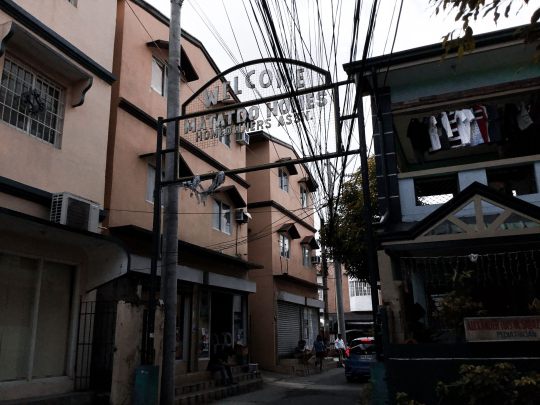
Pictured above is the entrance to Matatdo Homes. Below is a photograph of the lower portion of the compound near its southern border.
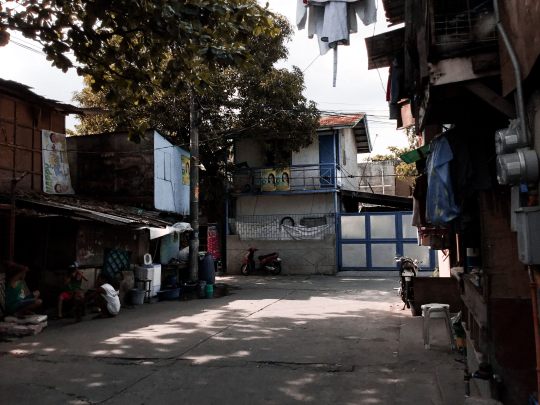
Pictured below is the gate of Greenheights Village.

The two photographs below are the two parts of the creek located inside the premises of the village.
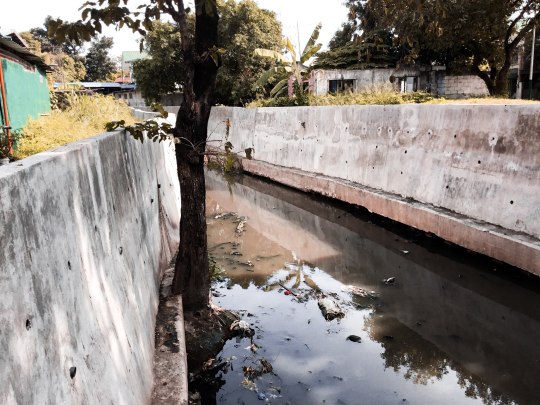
As one observes, the sides of the creek have now been cemented. However, the marshy part of the creek is yet to be cleared.
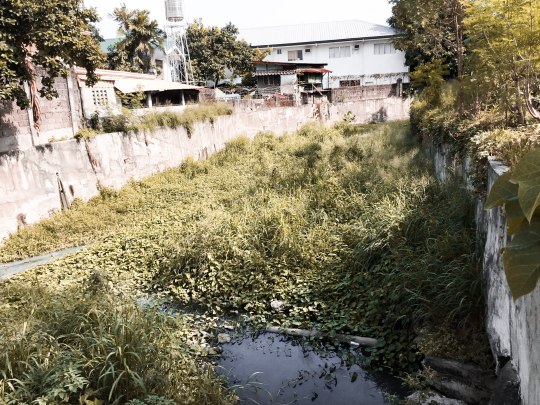
The most affected areas for flooding are Lopez Village, Vitalez Compund, Matatdo Homes, and a small portion of Greenheights Village where a creek is located. Lopez Village, Vitalez Compound, United Parañaque Subdivision 05 (shown below), and Matatdo Homes are similarly characterized by lower land area, poor drainage systems, and uneven roadwork.
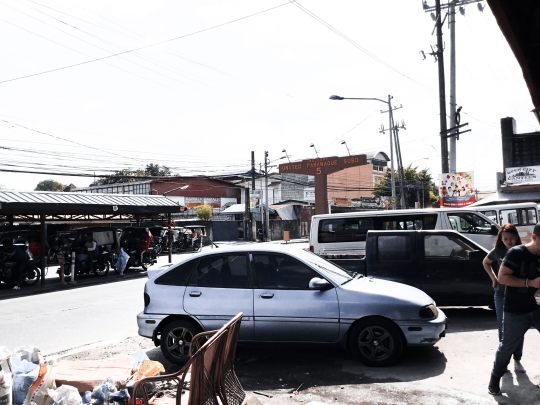
As a result, the rainfall from other areas of the barangay are caught in the said areas. The clogged drainages in the said places also contribute to the pooling and non-filtration of rainwater. As for Greenheights Village, although the subdivision is considered as one of the safest place within the barangay, the creek within its territory easily overflows during typhoons. What is more unfortunate is how the said creek is located at the middle of one of the schools, Escuela De San Lorenzo Ruiz, whose two buildings are connected by a bridge that passes over the creek. Apart from its nature as a body of water, the creek is also heavily polluted and is dirtied by garbage. This contributes to the impeded flow of water.

Of course, the barangay also has a list of the safest places within its territory. While the villages such as Greenheights Village and Krause Village are considered safe, the barangay only advices one place as a truly secured place in times of disaster. This is the Manila Memorial Park. While the place is a cemetery, it is considered to have one of the best area designs in the city. In fact, it is considered as the main evacuation point in case a large disaster hits the city. It covers a large area of flat land, has a very small number of structures that may collapse, and is on a relatively elevated part of the city. While there is also a body of water within its premises, the said body of water rarely overflows as the land area it covers is larger than that of the smaller creeks within the barangay.

The Manila Memorial Park which is pictured above and below serves as the emergency evacuation site of the whole barangay and its neighboring barangays.
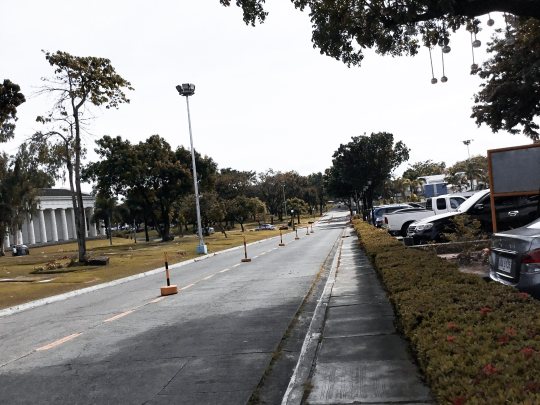
Of course, the barangay has ways to mitigate and manage the situations and conditions at hand. According to Mr. Salvaña and Mr. Concan, the barangay began by cleaning the drainage systems and addressing the overflowing of the creeks. As observed, the creek in Greenheights Village has since been cemented and today, the water rarely overflows as some efforts were made to clean the body of water. The disaster management division also holds seminars, trainings, and tournaments in the different villages and subdivisions of the barangay every four months based on the safety map that they have in their office. The participants are often youth members and these events are done in coordination with the different home-owners associations. I was informed by the interviewees that during these trainings, equipment such as manuals, first aid kits, and fire extinguishers to different households. Another one of the progressive and helpful practices in the barangay is how the local government is willing to give enough budget for the procurement of equipment needed for disaster management and for emergency responses during disasters and calamities. Such can be seen in the office of the disaster management division. In addition, Mr. Salavaña and Mr. Concan has also informed me that most of the members of the community have began to appreciate the need for preparedness. As a result, they no longer need to approach the different communities one by one as the respective associations of the said communities are now the ones to volunteer in sponsoring and pin participating in the events and projects that the disaster management division plans. Because of this progressive behavior the team behind the barangays disaster management is able to continuously improve. Now, they are even approached by schools such as the Philippine National University and the Far Eastern University to teach disaster preparedness and to educate on hazard and risk management in the said institutions.
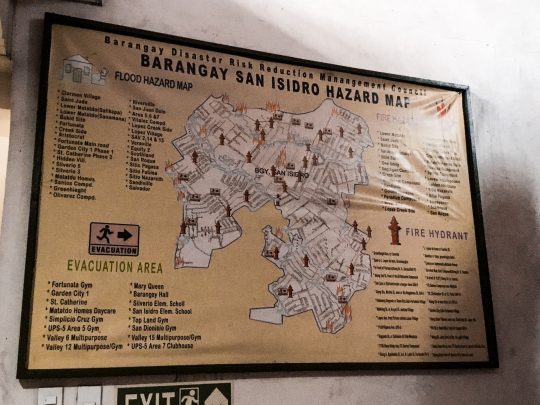
Pictures above is the Barangay Hazard Map and below is the manual that is distributed to the residents.

As shown below, the Barangay San Isidro is a recipient of recognition for its efficiency in disaster management and preparedness.

Pictured below are some of he available equipment for response emergencies.
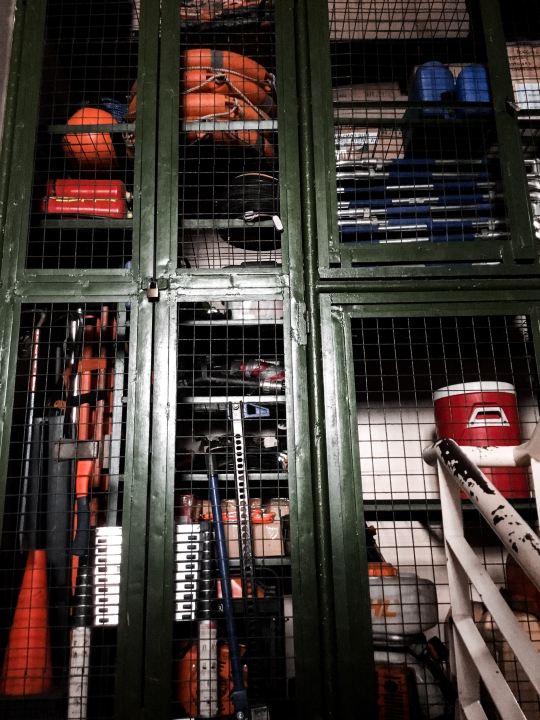
Fortunately for the barangay, the interviewees have informed me that there are very little concerns when it comes to disaster management in terms of the participation of the people. However, the trainings are only often attended by youth members. The main concern as of now is keeping the residents of the areas most susceptible to damage safe. Mr. Salvaña admitted that the team is unable to respond to all of the places at the same time during large calamities. He has also raised his concern on improving the conditions of the communities of informal settlers as it is not feasible or possible for the local government to provide better housing or better infrastructures for all of the residents of the said areas. This, of course, is understandable. The government needs to wisely consume its budget and with the thousands of homes within the hazardous areas, it is simply not probable or ideal for new homes to be constructed. Such a concern is raised as the said residents do not have the financial capacity to acquire better homes. Personal safety equipment is also not as accessible to certain parts of the community as they are to some of its other members due to economic status. In times of disaster, the people who live in the most hazardous areas are at a steep disadvantage as they receive the largest damage and have the least capacity to rehabilitate their homes and livelihood which may be destroyed during disasters. In the case of the barangay, the composting farm is located beside the creek in Greenheight Village, placing it in the direction greatly affected by the flooding that is caused by the creek.

The Faith Garden is a composting garden where common vegetable products are grown.
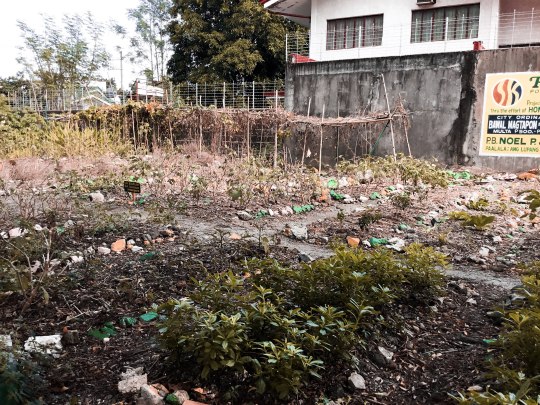
In response to this, the local government can focus on the prevention of the devastating effects of calamities and disasters from happening. As much as possible, the government must improve the public spaces where the hazardous places are. This includes cleaning and improving the drainage systems and fixing the already damaged roads and streets of these areas to ensure that emergency response teams can easily access these places when needed.
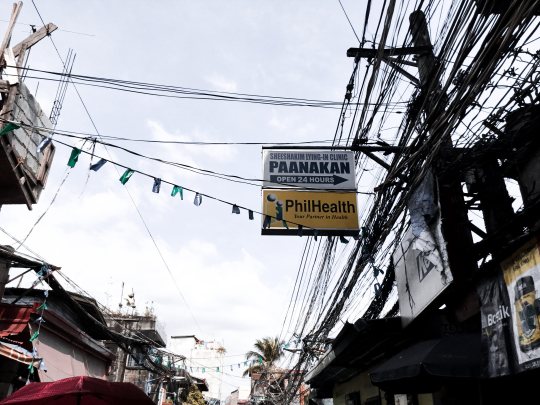
Pictured above and below are the streets of Silverio Compound.

Although some may negatively interpret it, the resilience of the people must also be strengthened. This includes effective emergency plans and consistent drills in preparation for disasters. An evacuation map for each community must be provided and evacuation practices must be continuously held in these areas. As an example, Kalayaan Village in Rizal holds these drills every few months to train the residents for an orderly and smooth evacuation in case a large calamity of an unpreventable disaster strikes. With the sprawling coverage of areas like Silverio Compound, it is important for the people to be trained for emergency situations and to be informed of the best routes to exit the area affected by the disaster. It is not realistic for the government to guard every area of the barangay during disasters. As a result, we as residents must also be informed and prepared.
There are instances when disasters cannot be prevented. However, we can improve the response to such disasters. The local government must make sure that emergency lines are available at all times and emergency response teams are present and well-equipped especially when the barangay already expects a certain disaster to hit. The local government can also heighten efforts in encouraging the community to volunteer as trained response team members. In addition, lessons on first aid may also be taught to the members of the community. This will enable every individual to be knowledgeable about emergency health care and able to provide temporary care to casualties in times of disaster. It is commendable that first aid kits are already being distributed in the households within the hazardous areas. However, this will not be truly beneficial if the people do not know how to properly administer first aid. As an addition, it would also be beneficial if weather-predicting instruments are given to the communities that live in more hazardous areas. The interviewees have informed me that such instruments are situated in Greenheights Village. While it would indeed be better for all of the areas to have their own gauges, it might prove to be more effective to provide these instruments to those who need it more. This way, the said areas would be able to know first-hand the nature of the typhoon that may hit in order for them to prepare immediately.
Similarly, these challenges are also present in the country as a whole. There are people and communities which are more vulnerable than others. First, the aging community and individuals with disabilities who have no immediate guardian may find it more difficult to respond and adjust during disasters. Not every Filipino live in places that are safe from calamities and disasters. Apart from this, not all of the citizens of the country have the means and capacity to pick themselves up after disasters that have heavily destroyed their homes and sources of livelihood. One of the biggest issues in terms if disaster management is the limited budget to acquire instruments in accurately predicting the strength of typhoons, to purchase enough and quality equipment for rescue operations during disasters, and to reach far-flung areas that have little knowledge on disaster manage and little means to rehabilitate their local community on their own. There are also a lot of illegal residential areas that are located in hazardous places. As a result, the said areas become a catch-basin for flood, a hot-spot for fire incidences, and highly dangerous places during earthquakes. In addition, a significant number of people even in the cities do not participate in disaster trainings with seriousness. During fire drills and earthquake drills, a number of people make a joke out of the situation and consider the activities as a waste of time. In first aid activities held in one of our classes in the National Service Training Program, some students who are laughing about the activity can be observed. This creates an unhealthy environment when it comes to teaching disaster management. In both the local and national sphere, the government cannot be the only entity responsible for disaster management. We, too, must be willing to support the projects of the government to address the problems concerning disasters by participating in national drills and volunteering to learn basic skills to raise the capacity of our community to reduce the damage that comes with calamities and disasters.
The interview, or as our facilitator pertains to it, the kuwentuhan, was truly a fruitful conversation. My appreciation for the whole team behind disaster management both in our barangay and in other barangays have grown more. Seeing how passionate the members were in their task made me realize how face our concern for the society around us can go. It has also made me appreciate my fellow residents as well who take it upon themselves to volunteer as members of the emergency response units despite having their own personal duties in work or in school. Hearing how the overall management of disaster in the barangay improved as members of the community began being more involved had made me realize how important it truly is for each individual to play his or her duty. Involvement in the community is a necessary aspect in the progress of the society. In a way, we must all use our resources and capabilities to look out for each other.

The photograph above is taken during the community walk while the picture below is taken before the community walk. With me are the members of the barangay’s fire and disaster management team.
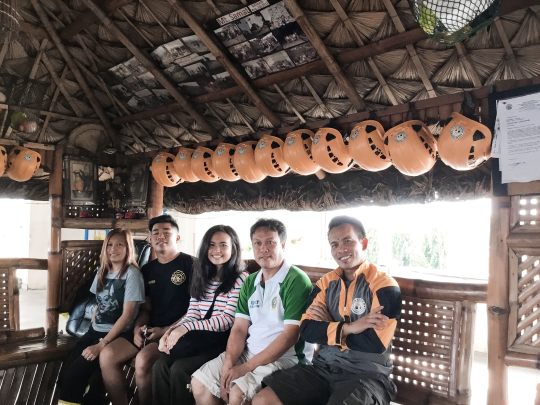
Seeing the different areas in our barangay has made me more aware of the disparity that exists even within one location. The hazardous places and safer places pose a stark difference between each other, much of which was due to economic differences. This disheartened me as such conditions should not be the reason why the lives of a group of people is placed in a graver danger than those of others. Because of this, I am even more dedicated to supporting advocacies that aim to address the inequalities in the society. As we can see, such issues are not merely concerned with education or profession; they also permeate to the capacity and vulnerability of an individual.
As one may have realized by the end of the activity, there are countless challenges to overcome when it comes to the disaster and risk management of the country. As a tropical country and as a nation that is located in the Pacific Ring of Fire, we are a hot-spot for natural calamities on top of man-made disasters. Striving to establish responsible disaster risk management among individuals should not be seen as a way of romanticizing the resilience or the ability of the Filipinos to adapt. Instead, it must be seen as a priority to prevent the damage to life and to property during catastrophes. As we are now aware of, safety from tragedies, whether natural or not, is not guaranteed for all of us. Thus, those who have the capacity and capability to help those in more vulnerable situations must be willing to assist in times of need. With an average of twenty typhoons entering the Philippine Area of Responsibility as estimated by the Philippine Atmospheric, Geophysical and Astronomical Services Administration, twenty-three active volcanoes, and active earthquake activity on top of armed conflict in certain areas and the unpredictability of fires accidents, it is important for all of us to be aware and prepared. To begin this, we must first be willing learners when it comes to the topic at hand.
Being a member of the youth should not limit us from being active members of the society. In fact, I was fortunate enough to take a photograph with the fellow members of the youth; volunteers who were taught Basic Life Support at the same time I interviewed the barangay officials. The photograph below shows the youth volunteers and beside me, the organizer of the event and barangay chairman, Mr. Noel J. Japlos.
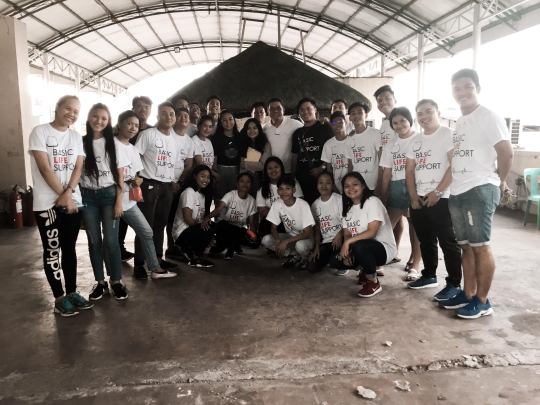
The active participation of the members of the community in disaster management is also one of the best practices within the barangay.
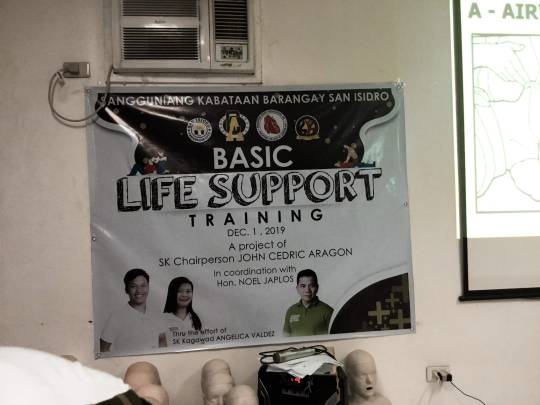
As young individuals, we have great capability to use our time and energy in volunteering to become responders during emergencies. The interviewees that I had the pleasure of having a conversation with has invited me to become a part of the youth responders in our barangay. In addition, even our own university offers a chance for us to participate in disaster management by holding first aid seminars and by offering opportunities to be part of the Philippine Red Cross. Of course, it is not possible for us to magically give a solution to areas with substandard infrastructures and to re-build stronger homes for our fellow Filipinos. What we can do is participating in the projects of our local communities where people are needed to teach skills related to disaster management. As individuals who are quite informed of effective disaster plans, we can use our learning to pitch project ideas and improved area designs for evacuation or for improvement. Even these small acts increase the capacity of our own community by boosting the number of individuals who are capable of addressing the problems brought by catastrophes.
As a student myself, I can accept the offer of the community to participate and train for the response team. Apart from being a responder, I would also be given the chance to pitch in my ideas on disaster management which I have learned during the course of the National Service Training Program Class that I have taken in the university. Of course, my knowledge is definitely not on par with my superiors. However, this will also be a good opportunity for me to learn new ways to become a more productive member of society.
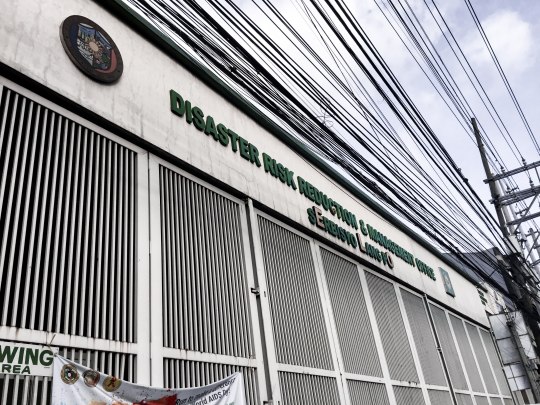
Pictured above and below are the facades of the two buildings that serves as the home for the city’s Disaster Risk Reduction and Management Office, located beside Barangay San Isidro’s hall.

I was informed by Mr. Salvaña that while the village I reside in, Greenheights Village, actively supports and sponsors the disaster management division of our barangay, there is yet to be a youth organization within the village with whom they can coordinate with for more physically demanding projects. As a resident of the village, I may approach the local association about the formation of such a group. This way, we can help in addressing the barangay’s need for manpower. As younger members of the society, the more rigorous activities that come with disaster management will be more easily performed by our age group than by the more elderly members of the community. The capacity of communities in not only measured by emergency actions. Political and social involvement must also be considered. In time, the learning that our group and organization would have acquired may be used to pitch ideas to the local government on better means to improve disaster management. This may range from simple seminars and drills to the annual provision of emergency equipment to the communities within the barangay. Even increasing the number of fire hydrants around the barangay can prove to be an effective measure towards preparedness. As the City of Parañaque heavily involves its youth members in projects, we have the opportunity to play concrete and proactive roles in increasing the capacity of our community by proposing realistic and sustainable policies on disaster management. Such policies include those that are focused on equipping individuals of knowledge about disaster and risk management and empowering individuals on disaster preparedness and response.
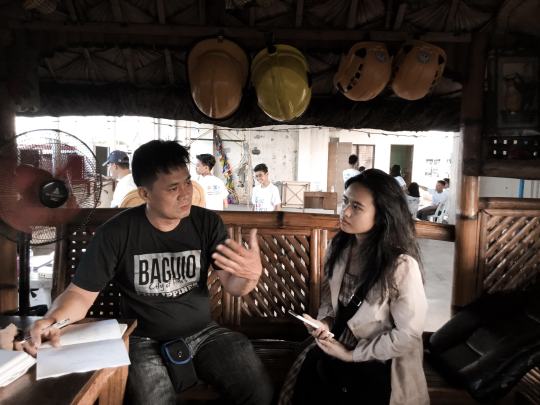
Mr. Fernando D. Concan poses for a photograph during after the interview.

The session of the interview had taught me innumerable lessons not only about disaster management, but on the entire concept of community as a whole. With a spark of hope and resolution, I left the confines of the barangay hall being more positive about my personal ability to become of greater help to my community.
2 notes
·
View notes